la
LOOKING BACK MOVING FORWARD
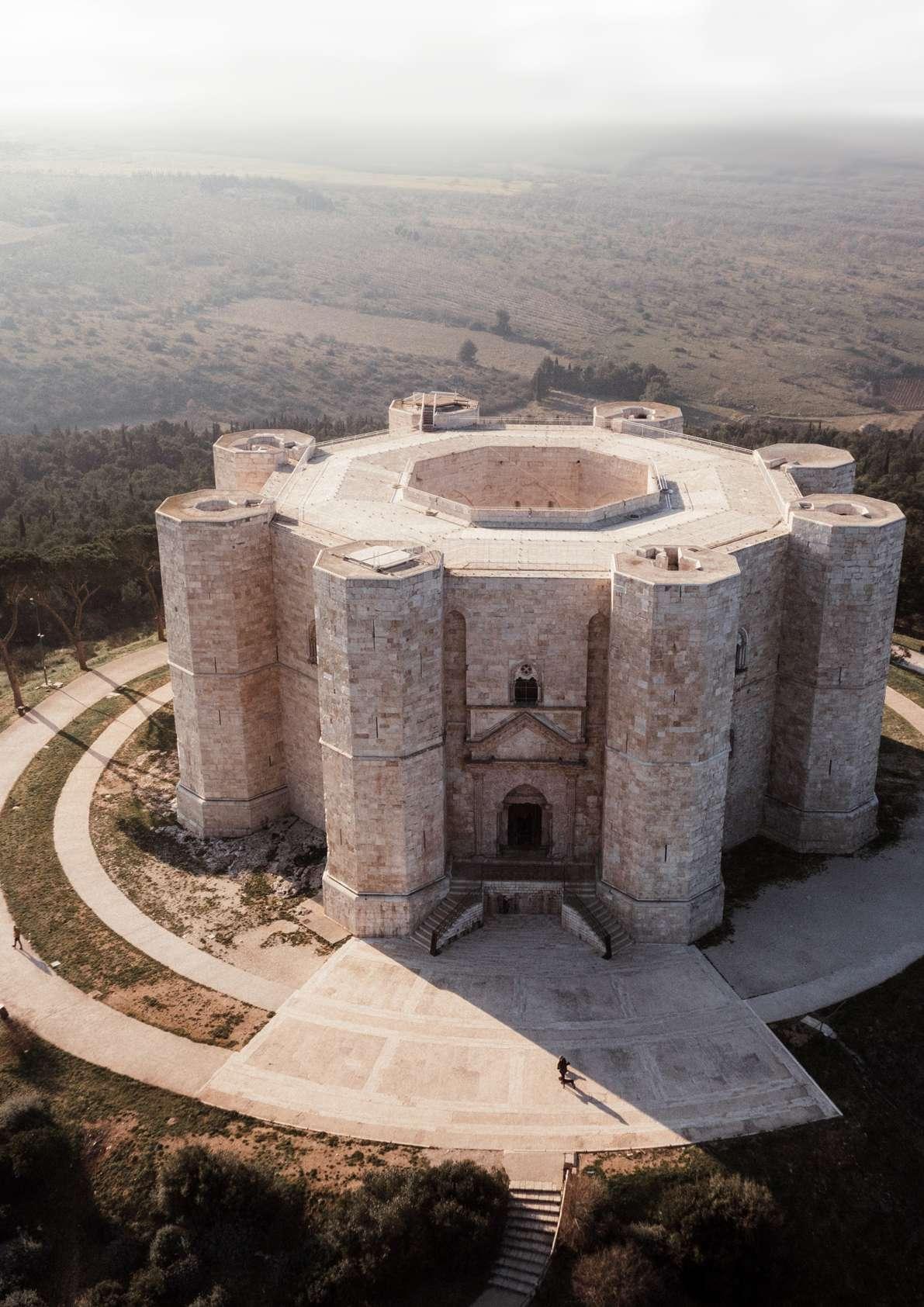
Issue XXX, Mar - May 2023
Strada






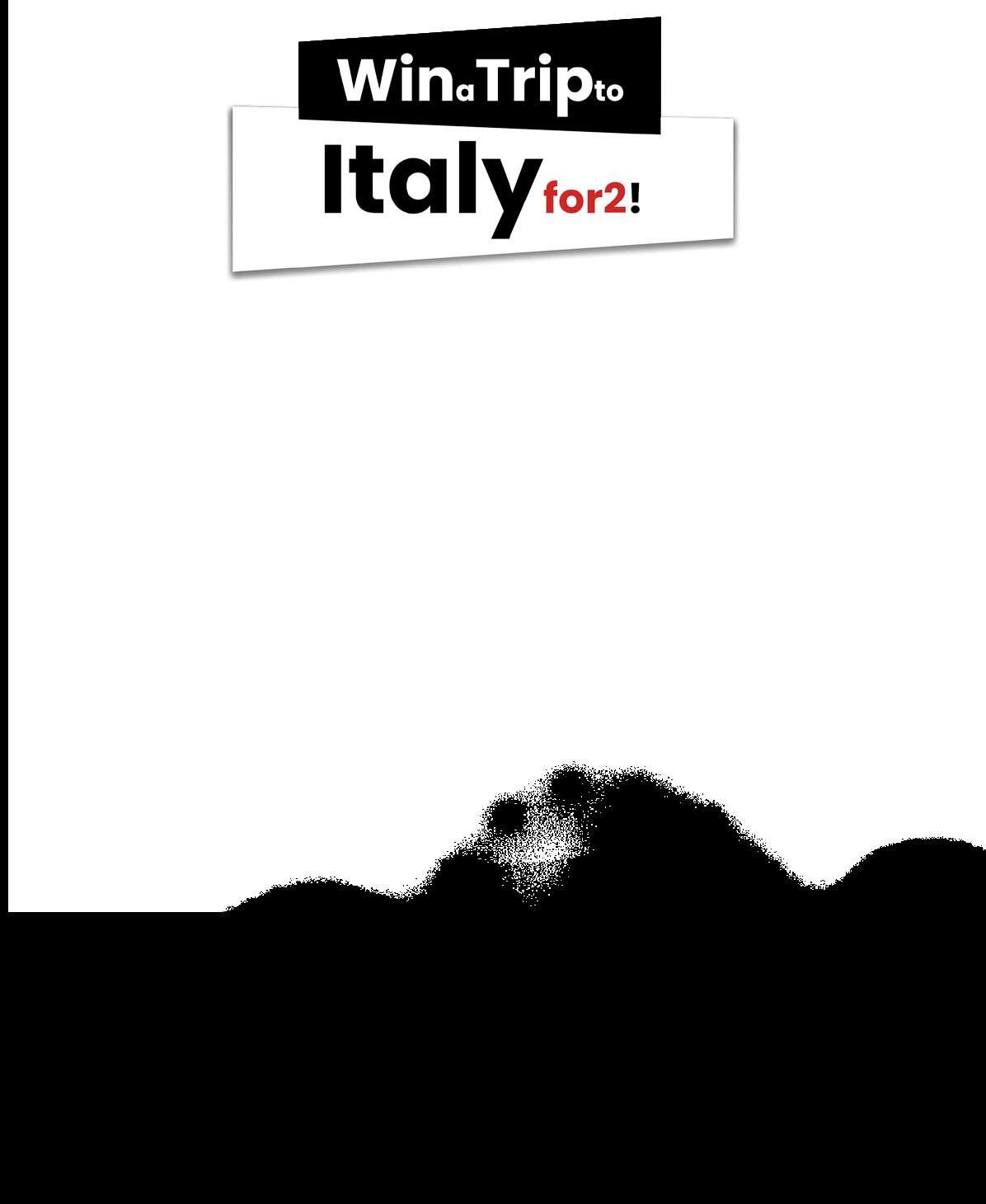




SHARE YOUR BEST PHOTO WIN A RETURN TRIP TO ITALY FOR 2! 1 2 3 TO ENTER THE COMPETITION: VISIT SEGMENTO.COM.AU TAKE A PHOTO (OR TWO!) TAG&SHARE ON YOUR PROFILE Choose your favourite t-shirt, cap or tote-bag. Available for shipping worldwide Wearing your favourite t-shirt, cap or tote-bag while visiting a special place or just having fun! Tag Segmento magazine on social media and share your photo on your public profile by 31/12/2023 FCO ROMA SYD SYDNE Y FCO ROMA SYD SYDNE Y Terms&Conditions: The competition ends on 31/12/2023. The Editorial Team at Segmento will select and award “Segmento’s best picture of the year 2023” and will notify the winner by 31/1/2024. The prize consists of two economy class return tickets from anywhere in the world to Rome. Travel period: September to November 2024. Final dates to be agreed with the winner(s). The prizes that may be awarded to the eligible winner(s) are not transferable or redeemable for cash. Other standard terms & conditions apply. Please visit www. segmento.com.au.
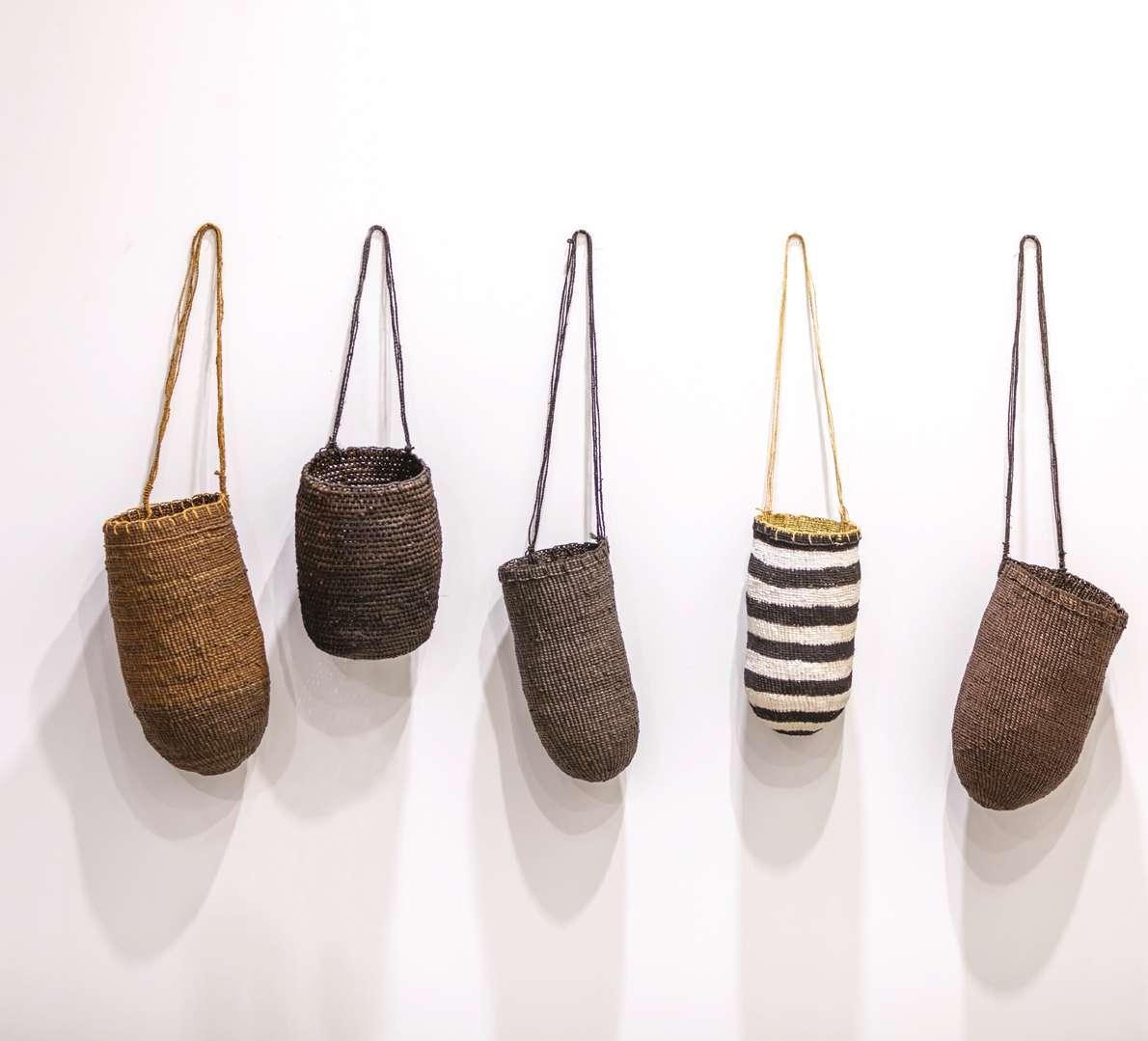
Segmento – Unapologetically Italian Issue XXX • March-May 2023
Cover Photographer
Alfonso Merafina
Publisher
Dr Giovanni Butera segmento@segmento.com.au
Editor-in-Chief
Nataša Ciabatti editor@segmento.com.au
Assistant Editor and Translator
Christopher Fotheringham
Graphic Artist
Aurora Delfino design@segmento.com.au
Website & Social media

Ambra Dalmasso & Edoardo Vijge socialmedia@segmento.com.au
Advertising on Segmento +61 410 860 036
Contributors to the XXIX Issue of Segmento
Photographers
Antonious Alexandre

Enrico Amici
Alessandro Bacchiorri
David Bignell
Marcello Bocchieri
Peter Brodbeck
Vincenzo Cascone
Giorgio De Finis
Michele D'Ottavio
Timothy Hillier
Alfonso Merafina
Paola Esposito Mocerino
Francesco Marino
Imma Petricciuoli
Jesper Storgaard Jensen
Writers
Gabriel Arata
Cristiano Capuano
Catherine Cervasio
Nataša Ciabatti
Ambra Dalmasso
Innocenza Giannuzzi
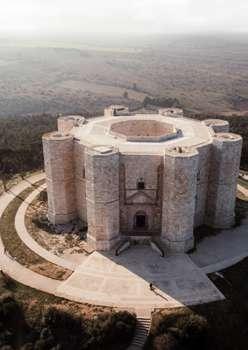
Agata Grimaldi
Lucy Laurita
Luca Morandini
Caroline Smith
Jesper Storgaard Jensen
Carla Trigilia
For general enquiries and back issues +61 410 860 036 segmento@segmento.com.au
Distribution
AU Melbourne
AU Sydney
AU Perth
AU Adelaide
AU Brisbane
AU Canberra

AU Cairns
CN Beijing
JP Tokyo
NZ Auckland
SIN Singapore
Subscription www.segmento.com.au/signup-page segmento@segmento.com.au
Segmento Pty Ltd
203 Maribyrnong Road, Ascot Vale 3032
Victoria Australia
Segmento acknowledges the traditional owners of the lands on which this publication was prepared and published. We pay our respects to Traditional Elders past and present. We pay respect to the age old traditions of all indigenous people.

Segmento proudly supports
The UN Refugee Agency is dedicated to saving lives, protecting rights and building a better future for refugees, forcibly displaced communities and stateless people. For donations please contact partnershipssg@unhcr.org
EverGreening focuses on massive land restoration efforts to address food insecurity, rural poverty, climate change and land degradation. For donations please visit www.donorbox.org/green-up-to-cool-down
Disclaimer: The Editorial Staff ensures that all details are correct at the time of printing, however the publisher accepts no responsability for errors or innaccuracies.

Issue XXX, Mar May 2023 Strada LOOKING BACK MOVING FORWARD la
segmentomagazine @segmento_magazine

The International Specialised Skills Institute


Direct action to build a better skilled Australia




The International Specialised Skills Institute (ISS Institute) exists to develop an innovative, skilled, and smart Australia by cultivating the mastery and knowledge of talented Australians through international applied research (i.e., industry-based) Fellowships.
www.issinstitute.org.au



ISS Institute is a registered charity. All
are fully tax deductible and go directly to fund
and education programs
The
donations
Fellowships
for Fellows.
Picture credit: Amy Franz, Italian Australian Foundation Fellow 2021
Where do we come from? Where are we going? These might be the two most fundamental questions around which we construct the stories we tell about our lives. At one end of the road is the past–certain and, perhaps, comforting; at the other end, the future awaits, unknown. Exploring the past is as important as envisioning the possibilities ahead of us. The road is a metaphor for our path through life and our search for a destination. It is not surprising that this concept appears in so many works of art and literature through the ages.
We open this issue by discussing the past and future of cinema with the general director of the National Museum of Cinema of Turin, Domenico De Gaetano. This edition’s theme is borrowed from an Italian film that won the Oscar in 1957 –La strada by Federico Fellini, with music by Nino Rota. In Fellini’s masterpiece, a childlike woman with a tin trumpet and drum announces the appearance of a coarse acrobat who must free himself from his chains. At the same time, a tightrope walker with cardboard wings watches from the sidelines. Fellini’s film anticipates the future, as the 1960s saw drama breaking out of the four walls of the theater and bursting out into the streets to reinvent itself. Theater spilled over into urban spaces, the suburbs, and places on the fringes of the city.
Similarly, street art today turns industrial spaces into places of memory–as in the case of the spectacular art project in an abandoned bitumen factory in Sicily–or places of hope–as you’ll discover reading about the only inhabited museum in the world. Dostoevsky claimed that art would

save the world. Perhaps if he were around today, he would say the same about street art.
The road is the narrative thread that runs through the 30th edition of Segmento. This issue is a chance to reflect on what we have achieved and imagine our future. The photograph on the cover depicts the inspiration for our logo, Castel del Monte, a place you can reach at the end of one of the most ancient and famous routes in the world–the Via Appia. In Rome, we explore an urban section of another famous route plied by pilgrims in the past and the present, the Via Francigena. Then we walk through the forested hills of Umbria in search of ancient abbeys with a fascinating story. Walking on the street, we also encounter our memories, like our writer who, in an unassuming streetside kiosk, stumbled upon the work of an artist who changed his life, Giosetta Fioroni.
The great storyteller Bruce Chatwin, who wore out hundreds of pairs of shoes traveling across countries and continents, used to say that the road is a journey to be made on foot. We hope the stories in this issue of Segmento will keep you company along the way.
Buona lettura!

7
Editorial
Segmento Issue XXX • Mar - May 2023
Nataša Ciabatti


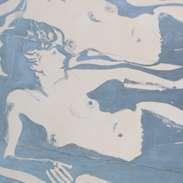

8 Segmento Issue XXX • Mar - May 2023 CONTENTS The Temple of Modern Storytelling by Nataša Ciabatti New Cultural Routes between Sicily and Indigenous Australia by Cristiano Capuano Early Footage of an Italian Journey to Australia finds a local Connection in WA by Caroline Smith ART & CULTURE A Spark of Inspiration by Innocenza Giannuzzi An unexpected Encounter with Art by Gabriel Arata Behind the scenes of My Brilliant Friend by Carla Trigilia 10 14 18 27 43 22 24 27 GLOBAL & SOCIAL ENGAGEMENT Editorial Viva Voce A Tavola Under the Cover The Unapologetics Alla Scoperta 7 20 58 69 77 78 22 24






9 31 35 FASHION & DESIGN The only inhabited Museum in the World by Jesper Storgaard Jensen La Bella Figura by
Laurita Segmento Issue XXX • Mar - May 2023 BUSINESS & INNOVATION Investment pathways in Singapore for Italian Firms by
En Route to Success by Ambra
Is AI promoting a Renaissance in the Arts? by Nataša Ciabatti 60 63 66 39 66 58 31 63 10 54 CUISINE & FOOD Chasing Nature’s Elixir
TOURISM & PLACES The Road to Paradise runs through Garbatella by Jesper Storgaard Jensen Of Pitchstone and Reminiscence by Cristiano Capuano Tale of Three Abbeys by Luca Morandini 39 43 47
Lucy
Agata Grimaldi
Dalmasso
by Catherine Cervasio
THE TEMPLE
OF
MODERN STORYTELLING
WHERE THE PAST IS PRESERVED AND THE FUTURE EMERGES
by Nataša Ciabatti | Photography by Michele D’Ottavio
Domenico De Gaetano, general director of the National Cinema Museum of Turin, arguably one of the most important museums in the world, guides Segmento on a trip through the origins of moving pictures and their future.

While we may not go to the cinema as often as we used to, we probably consume more films than ever before. Yet, as we scroll through the endless variety available on streaming sites or munch popcorn bathed in the blue light of the big screen, few of us give much thought to what goes into making the films we casually enjoy. Given how cinema colors our lives and its importance as a mirror and record
of our times, the value of a museum documenting the artistic and technological developments that have made this most modern and influential of art forms possible is immense. Yet, the role of the museum does not end here. In addition to being a repository where cinema-related artifacts are collected and preserved, the National Museum of Cinema of Turin doubles as an educational and creative hub.
10
GLOBAL & SOCIAL ENGAGEMENT
Segmento Issue XXX • Mar - May 2023
View of Mole Antonelliana, Turin, Italy
Domenico De Gaetano, on his second stint in the position, spoke about cinema’s rise to prominence as a modern artform and future challenges:


Cinema, the seventh art, is the most technological of all arts, as every transformation it undergoes is closely linked to technological inventions. People had played with the idea of moving images for over two centuries before the Lumière brothers developed the cinématographe. The next big leap was with the addition of sound, which brought about the end of silent film, including its acting techniques, and as a consequence, many careers. A third big shift happened when motion pictures went from black and white to full color. But then

celluloid story-telling experienced an even bigger transformation with the advent of television. Once it entered our homes, the ritual of going to the cinema was threatened, and today it is facing a similar challenge in the form of streaming. With every change, there were those who lamented the death of cinema, but it has always survived. Nonetheless, as a museum, we are committed to preserving the past as well as interrogating the future of the seventh art.
The museum is housed in the imposing Mole Antonelliana–the symbol of the city of Turin and one of Italy’s most recognizable landmarks, even appearing on the back of the 2-cent coin of the Italian euro coins series. Designed by
11 GLOBAL & SOCIAL ENGAGEMENT
Segmento Issue XXX • Mar - May 2023
Domenico De Gaetano
35mm Cinephon film camera (1935)
architect Alessandro Antonelli and completed in 1889, the structure, which held the record as the tallest masonry structure in the world until 1930, was originally a synagogue commissioned by the city’s Jewish community. When they could no longer afford the upkeep, it was sold to the City of Turin and transformed into a monument of national unity. Maria Adriana Prolo, one of the twentieth century’s most celebrated historians of Italian cinema and a prolific collector of cinema-related artifacts, recognized its potential as a worthy home for the national museum of cinema. Fulfilling her dream, the collection of the museum she had founded was moved from the Palazzo Chiabalese to the Mole Antonelliana in 2000.
After a dizzying elevator ride to the top of the Mole, I enjoyed a panoramic view of the snow-covered Alps and of the beautiful city of Turin before beginning

my visit to the archeological section, which reconstructs the human compulsion to tell stories through moving images. From the Shadow Play to the Camera Obscura to the Magic Lantern, everything is documented and can be experienced firsthand. Then comes the section devoted to the art and industry of cinema as we know it, with its stars, directors, costumes, and studios. After seeing Marilyn Monroe’s corset and heels and Fellini’s hat and scarf, walking underneath the original posters of movies that marked the history of cinema, and watching extracts of major motion pictures and musicals, I was led through an immersive pathway explaining how films are actually made from shooting, sound recording, and editing to special effects.
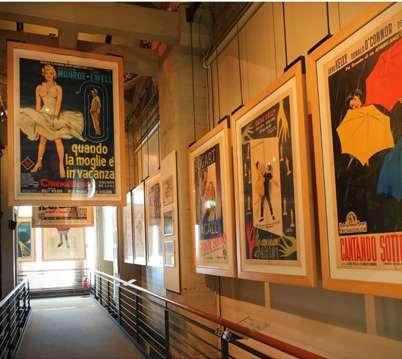
I then reached the center of the Mole, where I could hear the haunting scores of Dario Argento’s filmography. An exhibit that honors the work of this director, one of the most important Italian film-makers in the world, is currently on display at the museum. Co-curated by the museum director, Domenico De Gaetano, and Marcello De Garofalo, it conveys the

12 Segmento Issue XXX • Mar - May 2023
GLOBAL & SOCIAL ENGAGEMENT
The panoramic lift allows visitors to view the city of Turin from the top of the Mole Antonelliana
The Poster Gallery
power of Argento’s visionary worlds to the most avid fans and to the general public alike. At this point, before I am allowed into the virtual reality section, Domenico offers his thoughts about the future of cinema:

Today young people prefer series to movies and consume unprecedented amounts of audiovisual materials. They are also creators of videos that they share on social media, becoming directors themselves. However, they do not necessarily know the language of cinema. This raises questions about how the future of storytelling will look. Will it be an individual, isolated experience? Or will there still be a need to share stories offline? Will cinematographic art exist in the future? In what form? We have no answers, but we do pose these questions.
Responding to these gaps, the museum also takes its role in the educational arena very seriously, working with educators to produce curricular programs in film literacy.


The section formerly dedicated to 3D movies is now given over to virtual reality. You can experience full immersion in a virtual world, watching a film with VR goggles equipped with gaze-tracking technology. As I lost myself exploring an interactive desert landscape, forgetting altogether the cold drizzle and fog of the Turin winter outside, the possibilities of VR, both frightening and fascinating, became as vividly clear as the dry desert air of that artificial world.
Technological advancements have widened the gap between the generations, and it is hard to imagine how the old can communicate with the new, the past with the present. Without such dialogue, things will inevitably get lost along the way. The National Museum of Cinema of Turin is a place where this dialogue can take place. The museum gives visitors a peek behind the curtain and insights into the artistic and technological processes behind this universal form of storytelling that we so often take for granted.
13 Segmento Issue XXX • Mar - May 2023
GLOBAL & SOCIAL ENGAGEMENT
The Temple Hall
Virtual Reality room
NEW CULTURAL ROUTES BETWEEN SICILY AND INDIGENOUS AUSTRALIA
by Cristiano Capuano
Segmento meets Miriam La Rosa to talk about two organizations, Agency and FARM Cultural Park, committed to fostering connection to place in an authentic way.
How was this exchange envisioned, and from where has it taken its current shape?
Miriam La Rosa is a Sicily-born curator, researcher, and writer based in Melbourne. She is currently Art Projects and Research Manager at Agency. This Aboriginal and Torres Strait Islander-governed not-forprofit organization works as a catalyst to celebrate and promote Indigenous voices and Indigenous-led projects in the arts, cultural and environmental sectors. In 2019, she started to pave the road for a cultural exchange between Sicily and Indigenous Australia. This Italian summer is going to see an exciting new chapter emerge through a partnership between Agency and FARM Cultural Park.
The background of this project is a cross-cultural exchange between Sicily and Australia, which started in 2019 in the context of my PhD, and then reached a much broader scope. The project comprised a series of residencies, exhibitions, and a public program of events between three locations in Sicily –Catania, Favara, and Palermo–and two in Australia–Gunaikurnai Country, Gippsland, and the Aboriginal community of Peppimenarti in Ngan’gikurungurr Country, Northern Territory. The three artists involved, Regina Pilawuk Wilson (NT), Steaphan Paton (VIC), and Giuseppe Lana (IT), were invited to perform the roles of host and guest–both hosting and being hosted by their fellow participants.


Through this project, you established a connection with the Sicilian organization FARM Cultural Park. Can you tell us about your Sicilian host?
FARM is an award-winning and independent cultural center that aims to achieve social impact through urban and cultural regeneration. FARM is located in Favara, a small town in the heart of Sicily t hat, until 2010, had the highest rate of unemployment in the country. With the love, passion, and dedication of a couple of local philanthropists, Andre a Bartoli
14 Segmento Issue XXX • Mar - May 2023
Ngan'gikurungurr woman and senior artist Regina Pilawuk Wilson in residence at FARM Cultural Park, Sicily. July 2019. Photo
GLOBAL & SOCIAL ENGAGEMENT
Timothy Hillier
and Florinda Saieva, FARM managed to bring forward a project of rebirth of the city’s historical center which had been almost completely abandoned. Today FARM attracts over 100.000 visitors a year with a single event and is a major cultural hub, not only for Favara and the island, but also for the rest of Italy and beyond.
How has this connection with FARM further developed and grown?
We worked with FARM on location first, then they invited us to curate the Australian Pavilion of their Countless Cities Biennale, an initiative that celebrates the richness and diversity of cities from different parts of the world. In 2021 Agency brought to FARM a video installation of works by selected artists from the Mulka Project collective, the late Mr. Wanambi and Gutingarra Yunupingu, alongside a selection of images and videos from The Mulka Archive curated by Buku-Larrnggay Mulka Centre from the Aboriginal community of Yirrkala. This was the first contribution presented by Agency in the context of Countless Cities.
Was this even more engaging, considering the different ways we conceptualize the idea of a city across different cultures?
Yes. What defines a city is a rather complex and layered question. Is a city identified by the number of people that live there and the development of its infrastructure? Or by the importance that a place has within a region, for the people that inhabit
it? In this case, Yirrkala is an example of a thriving city in the contemporary (art) world.

What are the points of convergence between two organizations that operate in such vastly different contexts like Southern Italy and Indigenous Australia?
At a quick glance, Agency and FARM are two organizations that may not have much in common. Agency is based in Australia with a focus on the celebration and promotion of Indigenous people and projects in the arts and cultural sector. Agency ’s programs include exhibitions,
15 Segmento Issue XXX • Mar - May 2023
GLOBAL & SOCIAL ENGAGEMENT
Corben Mudjandi. Image Courtesy of Marrawuddi Arts and Culture
talks, events, residencies, publications, fundraising, and professional development activities. FARM’s scope is to expose the Sicilian community to a global discourse on art and culture, while retaining the authenticity and specificity of the place. In other words, acting as a bridge to the rest of the world from areas like Favara that are nothing like the touristy spots of Sicily where everyone goes on holiday.
The connecting thread between FARM and Agency is something we were able to formulate when we first visited with Peppimenarti-founder and artist, Regina Pilawuk Wilson. The way FARM operates in Favara resonates with the social function that many art centers perform for Indigenous communities across Australia. They act as hubs for community regeneration and are places where, not only art, but various forms of cultural, economic, and interpersonal relationships develop.
In essence, social impact links these two organizations located in two seemingly different and distant parts of the world. For FARM, making an impact is about creating otherwise missing opportunities for the local inhabitants, especially the younger generations. For Agency, the impact is about offering new perspectives to represent and support Indigenous arts and culture both nationally and internationally. In both instances, having a social impact is a clear objective.
Last year we contributed an exhibition for Radical SHE, an initiative of FARM that highlights women leadership and empowerment. Agency presented a video installation of works by Bundjulung

16 Segmento Issue XXX • Mar - May 2023
GLOBAL & SOCIAL ENGAGEMENT
View of FARM Cultural Park, Favara, Sicily, July 2019. Photo Timothy Hillier
and Ngāpuhi woman, visual artist, and dancer Amrita Hepi. There we strengthened the idea of a long-lasting partnership to continue exposing the work of Aboriginal and Torres Strait Islander artists to an international public while fostering reciprocity with projects that may also bring practitioners from the Mediterranean region to Australia. What will this thrilling connection bring forward in the next future?
In June-July of this year, for the 2023-24 edition of Countless Cities, Agency will curate once again curate the Australian Pavilion of FARM, which will feature an installation focusing on the town of Jabiru in the Kakadu National Park, as seen through the eyes and camera of Mirrar Traditional Owner and emerging artist Corben Mudjandi. Corben became very passionate about photography at a very young age and started taking photographs on film that document the life of his community and Country with an analog camera.
Jabiru is a peculiar place. The town was founded in the 1980s to accommodate the workers of the Ranger Uranium Mine. The Traditional Owners were dispossessed from their lands and their land rights were only recognized in 2021, after a long fight against uranium mining that began in the 1970s. The idea behind this exhibition,which responds to the Biennale’s themes of Pleasure in Cities and Youth Power, is to celebrate the reestablishment of a connection with place by the Mirarr people that Corben is documenting and putting at the forefront of his work.
The project will also include a residency for Corben in Sicily to meet local artists and organizations, and work with Palermobased publishing house 89books, for the production of a folio on his work. The results of his experience in Sicily will be presented in a follow-up exhibition in Melbourne in 2024, which will comprise an expanded version of the body of work that Corben will have developed for the Sicilian Biennale and, possibly, new work inspired by his residency.
What will the legacy of this project be? Do you see this project leading to a long-lasting connection that will allow other practitioners to develop exchanges on the route that Agency and FARM are tracing?
This project marks the beginning of a new, long-term partnership between FARM and Agency. The goal is to generate opportunities for professional development and practice expansion for Aboriginal and Torres Strait Islander artists and cultural leaders from Australia. The reason we are developing residency programs like this is that residencies lead to the establishment of often long-lasting connections, and deepen the relationship to places that a site-specific installation alone cannot sustain. Agency’s approach to the partnership with FARM is not simply about ensuring the delivery of an exhibition overseas but about building a safe channel for exchange where both organizations can nurture and steward the development of relationships for their respective communities.

17 Segmento Issue XXX • Mar - May 2023
GLOBAL & SOCIAL ENGAGEMENT
EARLY FOOTAGE OF AN ITALIAN JOURNEY TO AUSTRALIA FINDS A LOCAL CONNECTION IN WA
by Caroline Smith | Image provided
by
Caroline Smith
Rediscovered footage charting the journey of Italian and other migrants to Australia was central to the Fremantle Festival 2021. For the local musician who scored the festival’s background music, it was also an opportunity to retrace his family history.
Musician Pete Guazzelli created scores for numerous films on Perth’s festival circuit with the band Viola Dana. While searching for new material for the group, he discovered some old footage with a personal connection.

I was interested in seeing if there was an Australian silent film. There are some interesting early works. However, none of them felt right. When I came across a film entitled Dall’Italia all’Australia I thought that it had the potential to be something special and very different from our previous projects. The journey that my and so many families undertook in the first half of last century instantly drew me in.
The film reel-owned by Cineteca
Milano depicts the journey taken by migrants from Genoa to Fremantle in 1924. As Pete was watching, he realized he’d seen it before in video format at WA’s State Library. “I remember having watched it on one of their monitors and being spellbound,’’ he said. “Back then, I recorded as much as I could on a tiny hand-held video camera and took it home to show my father, who made that journey when he was ten in 1950.’’
Rediscovering the connection convinced Pete that this story should be shared with others.
Turning the footage into a fully scored film was a long process. It began with informal conversations about migration experiences fleshed out with background research.
18 Segmento Issue XXX • Mar - May 2023
Viola Dana (Pete Guazzelli, Kathy Potter, Tristan Parr, Joe Grech) perform at the screening of Tracing Family in Fremantle
GLOBAL & SOCIAL ENGAGEMENT
The first place I started was to contact my own family and friends who had undertaken this journey. From there, I searched for books on the subject, specifically letters and correspondence, to get a better feel of what the people who undertook this journey experienced, both from their journey and on arrival in Australia. Later, while researching my own family’s history, I discovered that my paternal grandfather had made the journey to Western Australia the same year of the film on the same ship, the Regina d’Italia This was an amazing discovery and made me look at the footage from a completely different perspective.
Pete spent the next six months writing the score. The musician and his bandmates drew on traditional Italian music and sounds inspired by the film reel itself.
I started the process by researching traditional folk songs from Italy and my memories of hearing family friends sing as a small child. As the ship leaves the familiar shores of Italy, I also thought it was important that the music makes its own departure. From this point, I attempted to underscore the arrival at new lands –Port Said, Suez Canal, and Colombo –with sounds and rhythms that reflect the possible uncertainty of the new for these passengers. Once the ship approaches Fremantle, the first Australian port, I decided to compose more traditional song forms into the soundtrack.
After an initial postponement due to COVID-19, the finished product –renamed Tracing Family: From Italy to Australia –was presented at the 2021 Fremantle Festival as part of its Ten Nights in Port program. Looking back on the screening, Pete recounted that he had been inspired by the resilience and bravery of those taking the journey–not only Italians but also Yugoslav (as they were known at the time), Greek, Arab, and Jewish migrants –all on board the Regina d’Italia.
The element that stood out to me from the stories was the courage that these travelers had to undertake an 8,000-mile trip by ship to a new country for the prospect of a better life for themselves and their families. Many were leaving a country in which they could not find work or faced political persecution, and although the land they arrived in was hostile and challenging, there were opportunities to be had. Once they had found work, many migrants sent most of their earnings back home to help cover the costs of running farms and supporting their families.
Pete’s rediscovery of his own family connection to the immigrants in the footage is the heart and soul of his musical score. It is stirring, layered, and rich in historical and cultural nuance. It elevates this important historical footage in a way that only an artist with an intimate emotional connection to the subject matter could achieve, paying homage to immigrants who, full of hope and trepidation, took the brave step into the unknown.
19 Segmento Issue XXX • Mar - May 2023
GLOBAL & SOCIAL ENGAGEMENT
Sabrina Morena nominates Le pupille by Alice Rohrwacher, already among the five finalists for the 2023 Oscars for Best Foreign Film for Italy
Alice Rohrwacher is a director whose work has always fascinated me. The film also features her sister Alba, a leading young talent in Italy, in the lead role. Le pupille is a short 37-minute film set in a boarding school for orphan girls during World War II. Presented at the Cannes Film Festival, where it was a notable success, the feminine predominates in the film–a significant contribution given the “meager presence” of female artists, especially among the directors, that was noted at the nominations. The victory of Alice’s film would be an achievement for women in the entertainment field who struggle to be recognized in leading positions and are often relegated to marginal roles.

SABRINA MORENA
Author, director, artistic director of the festival S/paesati

Gabriele Macrì nominates Francesco Rosi for a Lifetime Achievement Academy Award.

I recently visited the National Museum of Cinema and saw the exhibit Le mani sulla verità: 100 anni di Francesco Rosi (Hands on the truth: 100 years of Francesco Rosi) curated by Domenico De Gaetano and Carolina Rosi with Mauro Genovese and Maria Procino. The museum director, Domenico De Gaetano, calls Francesco Rosi “the director of civic and political engagement.” I share Rosi’s vision that art should not be neutral but should act to change the world. His films address important themes that are terribly relevant today, including the energy crisis, war, the Mafia, and the “Southern question.” It was great to see the exhibit, and I can’t wait to watch all his movies again with greater awareness!
GABRIELE MACRÌ

20 VIVA VOCE THE VOICES OF OUR READERS
Musician
Segmento Issue XXX • Mar - May 2023
Vanessa Paciocco nominates Federico Fellini as the epitome of Italian cinema.



For me, Italian cinema has always been a reflection of social problems; cinema adapts to the society of the time. Fellini is the epitome of this. His style changed profoundly during the 1960s, when postwar society favored more excessive tastes. Fellini responded to these changes with his own style –a departure from the scenes of the everydayness of his neorealist films to stronger and more poetic themes, as in La Dolce Vita . I was thinking of neorealism as the deeper cinematic movement in Italy –the representations of the reality of war particularly those dispossessed. Shooting on location and favoring non-professional actors, it’s not the Hollywood cinema we see in theaters today. For me, La Dolce Vita is a turning point for Fellini.
Segmento asks its readers to nominate their favourite Italian film director
I watched Piccolo Corpo at the cinema, and it is such a masterpiece for a debut work. No wonder it has already won two awards–the prestigious David di Donatello for Best New Director and the Premio Flaiano for best debut work. The film follows Agata (Celeste Cescutti) on a desperate journey to reach a mysterious sanctuary in the mountains of Friuli to save her daughter’s soul from the eternal damnation of Limbo. Mixing Catholicism and paganism, it portrays a spiritual quest for redemption. I found it timeless, and I can only imagine Laura will gift us with more of these stories in the future.

VivaVoce
21
ALICE MARTINELLI Architect at Studiomva
VANESSA PACIOCCO Teacher of Italian
Alice Martinelli nominates Laura Samani as Best Emerging Filmmaker
Segmento Issue XXX • Mar - May 2023
A SPARK OF INSPIRATION THE PAST AND THE FUTURE OF ITALIAN CINEMA ACCORDING TO ANNALISA INSARDÀ
by Innocenza Giannuzzi
From the vantage point of her long and varied career in Italian dramatic arts, Calabrian actress Annalisa Insardà talks to us about Italy’s place in international cinema.

Annalisa, what led you to become an actress?
My parents tell me that I wanted to be an actress since I was four years old. I don’t remember ever making a conscious choice to do it. I like to think that it was a passion I was born with. This would seem to be the case because I come from a tiny village in inland Calabria where there was no cinema when I was little. The nearest theater was a hundred kilometers away and beyond the reach of my parents. So when I was four years old in the ‘80s, the best I could do was watch cartoons. So I really don’t know where this desire, which became a need, comes from.
What is the place of Italian cinema in the world today? What power and value does it offer?
Though it has had its ups and downs, Italian cinema has always had the power to inspire. This may not be the case for the contemporary industry, but the triumphs of our cinema are still a reference point for many filmmakers. The strength of Italian cinema is its honest examination of the human soul. It tries to honestly narrate life in all its hypocrisy and squalor. It is not a technological spectacle or futuristic; it is not sensationalistic (not all our cinema, of course!). It intimately portrays interior worlds. When you give viewers a mirror, and they see their lives reflected, they have faith in you and trust you because they see themselves in your film.
Would you say that Italy is a perfect natural cinematic set?
Italy, if viewed with loving and wise eyes, can be anything you want it to be.
22 Segmento Issue XXX • Mar - May 2023 ART & CULTURE
Annalisa Isardà. Photo Francesco Marino
Why
are so many international directors passionate about Italy?

All drama relies on conflict. Italy is a county of such sharp contrasts that sometimes subtlety is not an option. We have breathtakingly regal historical cities on an imperial scale where the vestiges of a splendid past live cheek-by-jowl with ugliness, unease, indolence, apathy, and a sense of abandonment that prevails when people’s quality of life does not match the promise of so much beauty. These human and environmental contradictions are cinematic in themselves; they are real conflicts, and consequently, anyone choosing to tell their stories will be passionate about them.
Has Italian cinema contributed to world cinema, in your opinion, and how?
Art, like life, is flat and sterile if it lacks inspiration. Inspiration is a spark that can transform into a scorching blaze. Everything starts with a spark; it lights up your mind and guides you to your destination. I believe that our cinema, in the form of Neorealism, was the spark that shone in the eyes of the greatest directors of all time and that they used to light up the paths they took.
From the arthouse cinema of Rossellini’s Neorealism to commedia all’italiana to cinepanettoni, what is the future of Italian cinema?
I can’t be certain, but COVID-19 showed me that the only future possible is the present and the cinema of the present is highly varied, ranging from extremely frivolous to deeply important.
Do you think our cinema remains one of the best ways for us to promote Italy’s excellence and beauty abroad?
Cinema is an immensely powerful tool. Films teach us so many new things. Or rather, artists have used film to teach us. It is the best way to get the point across quickly and incisively. The internet has opened up so many options too, so cinema now means more than films on the big screen but also platforms that can be accessed with one click. Will poetry suffer? Maybe. Will our collective imagination become fractured? Without a doubt. But, in my opinion, film will endure as a means of raising consciousness.
Italian cinema remains central to Italian identity abroad. Tolstoy wrote, “If you want to be universal, start by painting your own village.” These days, more than ever before, in our multiethnic, globalized society, seeing glimpses of their own villages in films is not only a source of pride for our compatriots abroad but brings back memories, making the chords of their souls sing, and their eyes light up.
23 Segmento Issue XXX • Mar - May 2023 ART & CULTURE
Photo Alessandro Bachiorri
AN UNEXPECTED ENCOUNTER WITH ART
by Gabriel Arata|Images provided by CAMeC La Spezia
One day, as I walked down via Cavour, in the center of Florence, I stumbled upon an art book sticking out from a wobbly stack of assorted second-hand books on a kiosk. It was an edition of I disegni di Giosetta Fioroni.
Iimmediately experienced a vivid sense of déjà vu, a rush back in time, an emotional flashback. This collection of Fioroni’s drawings sent me on a trip to the deepest recesses of my memory. I was transported back to my own first childhood experience with art. I remembered sitting with my father, listening to stories about his childhood, his compulsion to draw, and his final exam at the art school in Milan. I remember him showing me his artwork. I was bewitched by it. I remember his figure drawings on brown paper, his soft, delicate brushstrokes, a faint line running over the paper. They were the skeletons
of portraits, sketches, but to me, it was art at its finest. They were the most beautiful thing I had ever seen.
Like me, Giosetta Fioroni grew up in a family of artists. Her father was a sculptor; her mother, a painter and a puppeteer. She lived and breathed art from her earliest moments. She grew up surrounded by words and images, poetry and theatre, living among easels, puppets, sculptors, and stages. A childhood so abundant in creativity and imaginary worlds would inevitably provide the basis for her body of work as she matured as an artist. She

24 Segmento Issue XXX • Mar - May 2023 ART & CULTURE
Giosetta Fioroni Exhibition, CAMeC La Spezia. Photo Enrico Amici
often added a sense of theatricality to her work. Her childhood experiences would guide her whole career and dictate her vision as an artist.
Giosetta portrays reality as if all life were a play, a place where anything is possible and where spaces are never clearly distinct nor limited by a frame. This element of space is notable in almost all of her body of work, where the work area is never delimited. Her work strains against the fourth wall. She has been called a Pop Artist but rejects the label, which she views as a distinct product of American culture. She differed from the likes of Andy Warhol, who tended to represent reality for what it is, as they saw it with their eyes. Instead, she belonged to the Scuola di Piazza del Popolo, a renowned group of Roman artists formed in the 60s in the post-war era. The group included internationally famous names like Tano Festa, Mario Schifano, Franco Angeli, and Cesare Tacchi, artists who were drawn to Pop Art and the nascent Arte Povera. The members gathered at Caffe Rosati in Piazza del Popolo or at the La Tartaruga art gallery, where the artists began to exhibit their work.
Her artistic divergences from her peers were most clearly pronounced in her constant and relentless exploration of femininity in popular culture. She was at pains to stress that her interest was not feminism but femininity. The distinction was paramount in this period of militant feminism.
In a society where femininity is often expressed through sexualized or vulnerable female bodies, Giosetta Fioroni focused on her models’ faces, on their eyes. Rather than objectifying women by showing them naked and offering them up to the viewers’ appetites, Fioroni lets us into their secret inner worlds. Looking at the faces of her models, it is not clear who is looking at whom, and they give the viewer an uncanny sense of looking into a mirror.
Viewing her work Bambino solo is enough to banish any doubts about her position as a modern master. Despite being produced in 1968, 54 years ago, the stirring portrait of a crestfallen child alone in the immensity of space with his back to the viewer, helpless to comfort him in his loneliness, continues to move anyone who sees it.
Observing Gli involucri (1967), we find ourselves before a unique expression of elegance, self-confidence, awareness, and audacity. The daring bravado of this painting, with its disregard for edges, frames, or boundaries and its play with palimpsest, silhouette, and process is strikingly modern. We can scarcely comprehend how revolutionary it must have been, given how thoroughly the advances she pioneered have since permeated modern art inspiring contemporary artists from the likes of Banksy to William Kentridge.
One of her most well-known collections was exhibited recently in London at the Luxembourg + co. Gallery. Giosetta

25 Segmento Issue XXX • Mar - May 2023 ART & CULTURE
Giosetta Fioroni, L’involucro, 1970
Fioroni: Alter ego presents her renowned and internationally praised Silver Collection. The artworks are rendered in silver aluminum paint and graphite pencil. The artwork of Giosetta Fioroni, throughout her long career, has always exuded a haunting etherealness and vivid spontaneity, and the artworks on show at this exhibition are no exception.
Fioroni’s art, especially in the Silver Collection, immediately transmits a great sense of calm with images seemingly suspended in mid-air, free, unlimited, barely opaque, almost indistinct from the space they occupy. She clearly sees and represents her subjects as intimate figures with psychological depth, turning them from mute objects into eloquent beings.
L’Argento (Silver Collection) is also notable for having been Fioroni’s first solo exhibition in the United States in 2013, at The Drawing Center in New York: a great achievement.

We often see silver in art, but, in Fioroni’s work, it doesn’t represent a precious metal. Rather, in her own words, silver is the quintessence of “non-color.” It can both absorb and reflect light. The artworks are nearly monochrome, like in the work of Yves Klein, but unlike Klein, Fioroni limited her monochrome techniques to an experimental phase.
Fioroni participated at the Venice Biennale in 1956 and 1964, and was assigned a personal exhibition space at the 1993 Venice Biennale. Finally, in 2003, her place of birth, the city of Rome, dedicated a retrospective to her, La Beltà exploring her career from the beginning up until the exhibition.


With her personal view of the world and femininity, she ultimately made her mark within a male-dominated society, and her pioneering work remains relevant today. From the beginning, Fioroni’s art has always been ahead of its time. Giosetta Fioroni’s art could only be described as perfect harmony. Today, as I walk on the same street where I encountered her for the first time, though the kiosk is no longer there, it feels like closing a circle, giving myself the balance I have always sought.
Now showing at the Centre of Modern and Contemporary Art in La Spezia (CAMeC) is the exhibit “ The Small Large Heart of Giosetta – Giosetta Fioroni works from 1960s to 2000s”. We thank CSArt – Comunicazione per l’Arte – for providing us with the images.
26 Segmento Issue XXX • Mar - May 2023
Giosetta Fioroni, Ramo d'oro, 2014
Giosetta Fioroni, Teatrino a 7 anni, 1979
ART & CULTURE
Giosetta Fioroni, Stavroghin, 2009, courtesy Fondazione Parise
BEHIND THE SCENES OF MY BRILLIANT FRIEND
by Carla Trigilia
At the age of 19, Francesca Montuori found herself starring in My Brilliant Friend–Season 3: Those who leave and those who stay. She spoke to Segmento about her experiences on set and her most memorable moments.

The series, based on Elena Ferrante’s bestselling book by the same name, begins in the post-war period in the poor Luzzatti district of Naples. Now one of the most acclaimed Italian television series, it portrays a long and complex relationship of friendship and conflict between two women –Elena Greco and Lila Cerullo. Ranging from obsession to jealousy and spite, this intimate portrait of the lives and loves of these two characters plays out against the backdrop of momentous social and political upheaval as Italy transforms from a poor and backward nation ravaged by war into an economic powerhouse, though leaving many behind. Francesca Montuori plays the character Elisa Greco, the younger sister of the main character Elena.
When did you know you wanted to be an actress?
I was eight years old when I stepped on a stage for the first time. I immediately realized I belonged, and all my shyness that dominated in those days suddenly disappeared. I don’t think there’s a specific reason why. I guess I was destined to be an actress, but also, I have a natural predisposition for performing in front of a camera.
27 Segmento Issue XXX • Mar - May 2023
ART & CULTURE
Francesca Montuori. Photo Petricciuoli & Mocerino
Can you tell us about your experience on the film set of My Brilliant Friend and what you did to better prepare for the role of Elisa Greco?
I watched My Brilliant Friend as a spectator. I was struck by the depth of the writing and, above all, its truthfulness. When I found out I was going to play Elisa Greco, I prepared as much as possible with the acting coaches and Daniele Luchetti, our director. I tried to leave room for all the feelings flooding me during those intense weeks of rehearsals with the other actors. I understood and learned that only by dragging myself into the emotions and then emptying myself of them could I really understand the character I had to play.

You started acting in a series, now in its third season, with a cast of actors who already knew each other and had worked together before. What was your first day of filming like? What did you feel?
The first day I heard “action” was unforgettable! I still remember the crew and the amazing people who worked tirelessly alongside us. We had to shoot a beautiful scene where the two Greco sisters, Elisa and Elena, meet each other after being apart for more than five years. The scene where Elena gives the earrings to my character was magical. I can still feel the adrenaline of that moment.
How did your co-stars receive you? Did you form any special friendships?
I tiptoed in, but they were great! They welcomed me with so much love, and I really bonded with everyone.
What do you like and dislike about your character?
I love her enchanting gaze and how she takes life into her own hands despite everyone. Although Elisa made a harmful and risky choice, I am glad that a young woman in the 70s still had the power to make choices for her life, which is not something taken for granted.
What was the most difficult thing for you working on this series?
There was no real difficulty. The film director was always ready to help me if I had any doubts or uncertainties. When I debuted, I was a little scared, which is fair. I was anxious about how the audience would react.
Do you have any funny stories about the shoot?
It was fun when we were filming the lunch scene. We ate together for a week between ten o’clock in the morning and two o’clock to practice for the scene. It was fun; we laughed a lot and created crucial bonds that made the scene successful.
It is unclear whether Francesca will play Elisa again in the fourth and final season. What we do know for sure is that we will soon see Francesca in a short film about Naples based on Massimo Piccolo’s book Layla

28 Segmento Issue XXX • Mar - May 2023
ART & CULTURE
Francesca Montuori in My Brilliant Friend.
Source: Wildside, Fandango, Rai Fiction, HBO
Francesca Montuori plays Elisa Greco in Season 3 of My Brilliant Friend. Source: Fremantle, The Apartment







We do we care for “ “ what we do best: our community CO.AS.IT. Italian Assistance Association AGED CARE SERVICES • ITALIAN CLASSES • CULTURAL EVENTS RESOURCE CENTRE • ITALIAN HISTORICAL SOCIETY • MUSEO ITALIANO 189 Faraday Street, Carlton 3053 VIC 03 9349 9000 coasit.com.au coasit@coasit.com.au
THE ONLY INHABITED MUSEUM IN THE WORLD
by
It is safe to assume that the two hundred or so formerly homeless people and immigrants who today live in an abandoned factory on Via Prenestina on the outskirts of Rome have more pressing things to worry about than Fyodor Dostoevsky’s ideas about art. Despite this, his famous phrase, “beauty will save the world,” is currently at the core of the community’s survival.
Here on the shabby outskirts of Rome, about ten kilometers east of the center, there isn’t exactly an abundance of beauty. Indeed, this area seems quite unloved. Used car dealerships, supermarkets, ramshackle developments, and pavements
littered with garbage line Via Prenestina. However, this somewhat bleak area is interrupted at number 913. Here beauty suddenly appears. A pair of crystalline eyes are painted on a large wall –a colorful mural with an almost hypnotic gaze created in 2014 by Brazilian street artist Eduardo Kobra. It radiates a strange curiosity and a hint of wonder.
Beyond the high walls, a disruptive, uncanny, decidedly rebellious beauty is on display. On the old factory floor, you can see dozens of works of art embellishing walls, facades, and doors. Wherever you look, an artist has jostled in an artwork wherever physically possible.
 Jesper Storgaard Jensen | Images provided by Jesper Storgaard Jensen
Home to 200 people, this abandoned factory on the outskirts of Rome is a treasure trove of beauty with more than 650 works of contemporary art.
Jesper Storgaard Jensen | Images provided by Jesper Storgaard Jensen
Home to 200 people, this abandoned factory on the outskirts of Rome is a treasure trove of beauty with more than 650 works of contemporary art.
31 FASHION & DESIGN
Segmento Issue XXX • Mar - May 2023
Kobra, Peace (2014). Photo Giorgio de Finis
Giorgio de Finis, anthropologist, curator of exhibitions, and former director of the well-known Museum of Contemporary Art of Rome (MACRO), was aware that the site risked demolition: “I discovered this place by accident. In 2009 I went for a walk in the area with a group of artists. When we passed this abandoned factory, we found that around 200 people from around the world were squatting in the area.” According to de Finis, they live here illegally. The place had impressed him, and he returned two years later to involve the locals in an experimental project –building a fake rocket to simulate a trip to
a friendlier place–the moon. “This is why we chose the name Metropolitz Museum of the Other and Elsewhere (abbreviated as MAAM in Italian), for the future museum, where the Elsewhere is meant to represent the moon,” explains de Finis, smiling.
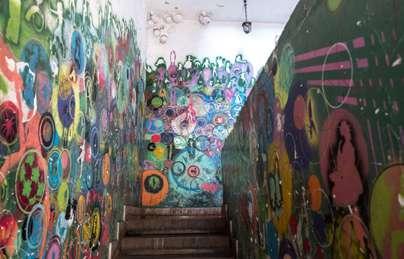

The old factory belonged to Fiorucci, a manufacturer of charcuterie goods, who years earlier had moved their operation elsewhere. Subsequently, the site was purchased by one of the largest Italian construction companies, Salini, which, in 2012, had the area rezoned from industrial to residential. The old factory


Segmento Issue XXX • Mar - May 2023 32 FASHION & DESIGN
could soon be demolished to make way for new residential buildings.

“When I learned that the demolition of the factory was lurking, I got an idea,” says de Finis. So, starting in 2012, he began calling on his contacts in the street art world, some of whom already boasted a solid international reputation. “Today, the figures are staggering. Around 450 artists have created more than 650 works here at MAAM,” explains de Finis.
MAAM represents a gigantic explosion of artistic creativity wherever you look. Here, every square centimeter seems
filled. Colors, imagination, creativity. Everywhere. It is impossible not to be amazed.
There are well-known names among the artists, such as Kobra, Solo, Diamond, Lucamaleonte, and Alice Pasquini, the world ’s most famous Italian street artist. And then there is Aladin, from Yemen, who created an impressive apocalyptic scene based on the G8 summit in Genoa in 2001. There are still about 200 people (65 families) living at MAAM. Walking around the old factory, you can see teenagers playing football and laundry hanging among dozens of works of


33 FASHION & DESIGN Segmento Issue XXX • Mar - May 2023
Photos Jesper Storgaard Jensen
Mural by Alice Pasquini
colorful street art. They are the residents of the only inhabited museum in the world. Unfortunately, they now risk eviction. In 2018, the Civil Court of Rome ruled in favor of Salini, which sued the municipality of Rome for compensation to the tune of 28 million euros for failing to clear the site. This ruling was a severe blow, and MAAM is on a municipal list of the five sites most at risk of demolition.

“But now, how do you go about raising all this beauty to the ground? This is our idea –beauty as a bulwark against demolition. Art as protection which, at the same time, has the task of emphasizing the universal right to housing,” says de Finis. He adds: “It is important to get the right message across. We try to make ourselves known. Last year we participated in the Venice Biennale, and we are currently collecting all the necessary material to present MAAM’s candidacy for UNESCO protection by the end of February this year.”
However, with the new municipal administration in Rome, the wind seems to have changed slightly. A part of the Democratic Party (PD) seems to have the fate of the MAAM at heart, and perhaps even the imminent UNESCO candidacy could have positive effects. It remains to be seen whether Dostoevsky was right about beauty saving the world in the case of MAAM, but we remain hopeful.
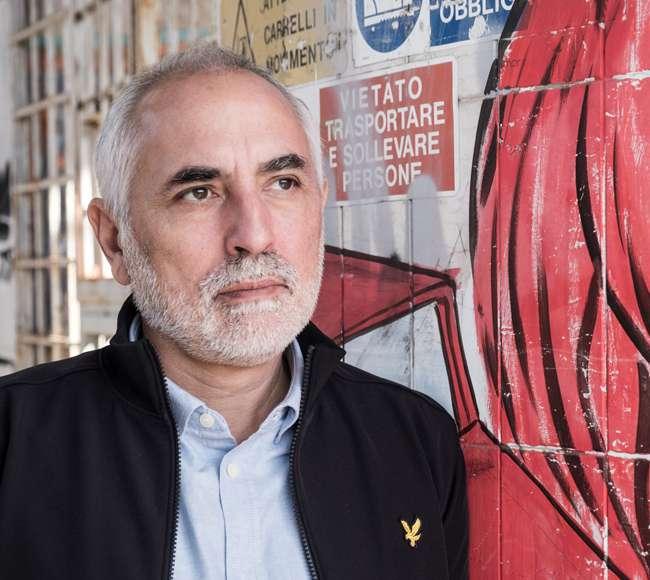
34 Segmento Issue XXX • Mar - May 2023 FASHION & DESIGN
All this has only been possible due to Giorgio De Finis’ creative thinking and his personal network to a myriad of international artists. Photos Jesper Storgaard Jensen
LA BELLA FIGURA ITALIAN STYLE FOR BUSINESS SUCCESS
by Lucy Laurita | Photography by Peter Brodbeck & David Bignell
The need to make a good impression is ingrained in Italian culture. How does this translate across cultures?
It is undeniable that seeing a person with impeccable style pass by is captivating and intriguing. Successful Malaysian Australian business executive Christina Chia shares her love of Italian styling from food to fashion and the value of adopting and maintaining the frame of mind of la bella figura

I love visiting Italy, and I’m inspired by Italians’ dress sense and the quality of their fashion products. On a holiday years ago, traveling through Italy, I met a shop owner in Milan who shared the words la bella figura . The literal translation is “the beautiful figure,” and he went on to say that it is more than just dressing well; it’s a way of life–your appearance, your manners, your confidence, hospitality, food, friendships, and more. It encompasses your entire personal demeanor.
Christina is an award-winning C-suite executive and a community champion. Recognized as a leading authority, she derives joy from serving, leading, and building meaningful connections to advance our communities. As a strategist, she was able to create opportunities for sustainable value under the tough economic conditions of the COVID-19 pandemic. In recognition of her achievements, she received the Victorian Multicultural Commission Award for Business Excellence in 2020. She was recently inducted into the inaugural Victorian
35 Segmento Issue XXX • Mar - May 2023 FASHION & DESIGN
Christina Chia
Multicultural Commission Honor Roll in recognition of her contributions to the Victorian community, especially in raising over $300.000 through volunteer and community roles over the past decade. It seems Christina has always had a sense of la bella figura coupled with a can-do attitude:
I arrived as a migrant in Australia with two suitcases and my two little girls, with hopes for a better future and opportunities, and my faith and willingness to work hard matched my courage to make it happen.
Christina wears many hats and has crafted her method to successfully get back to face-to-face meetings and public speaking.
My style is a mix of classic elegance with contemporary, comfortboosting confidence. Wearing statement pieces by high-end Italian designers is more than a brand for

me. It’s the style and how it makes me feel. Maintaining a healthy glow from the inside out starts with a positive mindset. Smile! It is always your best accessory.
With a demanding work schedule and passionately committed to her community, life can be frantic yet exciting. She prioritizes mental and emotional wellbeing with meditation, lots of breathing, and time for herself to reset, recharge, and rejuvenate.
To alleviate anxiety, I go over my outfits for the next day each night before I go to bed. Your style is your voice without speaking. As a senior corporate executive, it is critical to dress for success as the perception can translate to performance. I believe that a person’s dress sense reflects personality, character, mood, style, and individuality. It tells a story about you.
36 Segmento Issue XXX • Mar - May 2023 FASHION & DESIGN



COSENZA - ITALY MELBOURNE- AUSTRALIA www.stevenshats.com | Australia Ph: 0410 860 036 eMail: info@stevenshats.com stevenshats@gmail.com
THE ROAD TO PARADISE RUNS THROUGH GARBATELLA
VISITING THE MODERN ROMAN SUBURB AT THE HEART OF EUROPE’S SACRED GEOGRAPHY
by Jesper Storgaard Jensen | Photography by Jesper Storgaard Jensen
Starting in Canterbury, the Via Francigena crosses four countries ending at the southernmost tip of Puglia. Rome remains the highlight for most pilgrims along the route, and the city’s Garbatella district bears witness to its historical and spiritual importance.

The Via delle Sette Chiese, in the Garbatella district south of Rome’s historic center, runs between two of ancient Rome’s most important highways –the Via Ostiense, which connected the city to the port in Ostia, and the Via Appia, which linked the Eternal City to Southern Italy. As its name suggests, the road boasts seven important churches that were, and remain, among
the highlights for pilgrims arriving in Rome.
Historical records and stories surrounding the Via delle Sette Chiese date back to the early Middle Ages. The faithful believed that visiting the seven churches along this 20km route would absolve them of their sins. The route played a significant role in the life of Saint Begga, a 7thcentury Frankish noblewoman of whom
39 Segmento Issue XXX • Mar - May 2023
TOURISM & PLACES
Basilica of San Paolo fuori le Mura
Charlemagne was a direct descendant. After being widowed, she devoted herself to religious life and decided to make the arduous pilgrimage to Rome from her home in Metz. In Rome, she visited the sacred churches and basilicas of the city along the Via delle Sette Chiese. She was so struck that, upon returning from Rome, she commemorated them in the form of seven chapels she built at the convent where she would live out her days in prayer and contemplation.
By the late Middle Ages, the pilgrimage route had become an established tradition in the religious life of Rome. Records from 1550 indicate that Michelangelo and painter-historian Giorgio Vasari walked the pilgrimage route in each other’s company. The two men also walked the section of the route that led them through Garbatella.

Nearly 500 years on, you can retrace the path that these Renaissance masters once took. The itinerary begins in Ostiense at the monumental Basilica of San Paolo fuori Mura, one of Rome’s seven basilicas and one of the four papal basilicas of the city. It is noted for its large, open interior space and magnificent ceiling. Only a few fragments remain of the original 4thcentury structure that Saint Begga, Michelangelo, and Vasari would have visited. The basilica was destroyed by a fire in 1823 and rebuilt.
Continuing along Via Ostiense for a few hundred meters, you will reach the start of Via delle Sette Chiese. Continuing along the road, at the intersection with Via di S. Adautto can be found a madonella, a statue of the Virgin Mary and child of the type seen all over Rome’s historic center.

40 Segmento Issue XXX • Mar - May 2023
TOURISM & PLACES
The impressive San Paolo fuori le Mura seen from the inside
Commodilla Park, with its catacombs that can be visited by appointment, is the next landmark along the route on the southern side of the road. Along the northern side of the road, you can catch glimpses of several of the neighborhood’s idyllic courtyards. The road then leads to a busy square, the Largo delle Sette Chiese, where the most recent addition to Garbatella’s artistic treasures can be viewed. It is the striking mural Amor et cura by Chilean street artist Carlos Atoche, unveiled in May 2021.
A little further on is the small church of Corpus Domini that belongs to the order of nuns, the Suore Discepole di Gesù
Eucaristico. It is a modern church built in 1953. Going inside, you might see nuns sitting in silent prayer.
A few hundred meters on, you can strain your neck to catch a glimpse of Garbatella’s most centrally located church –the Church of San Francesco Saverio, built in 1933. The church is named after the Spanish Jesuit missionary, Francisco Xavier (1506-1552), who was active in India and Japan. He was canonized in 1622, and in 1747 became the patron saint of Indian Catholics.
Arriving in Piazza di S. Eurosia, two churches situated just a meter apart meet the eye. The first is the small church, Chiesoletta dei Santi Isidoro ed Eurosia. This place is the halfway point between the great basilica of San Paolo where you started your journey, and your final destination, another basilica, San Sebastiano. On the facade of the small church facing the piazza, you can see two bas-relief stones figuring San Filippo Neri (on the left) and San Carlo Borromeo (on the right). They are believed to have met here in 1575. On the same facade, you’ll also be able to spot the inscription Via Paradisi (Paradise Road), testifying to the faith of the countless pilgrims who have trudged this path in search of their own paradise.
Beyond the Chiesoletta dei Santi Isidoro ed Eurosia is yet another church–San Filippo Neri in Eurosia, built between 1952-1955 and dedicated to a Renaissance-era priest who became a saint and whose spiritual life was intimately connected with the Via




41 Segmento Issue XXX • Mar - May 2023
TOURISM & PLACES
Church of San Francesco Saverio
The Corpus Domini Church
delle Sette Chiese and the Basilica di San Sebastiano and its catacombs.

Walking on for a few minutes, you will arrive at the chaotic roundabout of Piazza Oderico da Pordenone. Gingerly crossing the piazza and keeping slightly left, you will rejoin the Via delle Sette Chiese. After a few minutes, you will reach a crossroads. Here turn left and head in the direction of the nearest pedestrian crossing to cross the wide six-lane Via Cristoforo Colombo. On the other side of this major road, you will arrive at Piazza dei Navigatori. Don’t miss the modern obelisk, La Meridian (The Clock), created by Luigi Gheno to mark the 1990 Fifa World Cup held in Italy. Finding your way back to the Via delle Sette Chiese you will reach another roundabout called Largo Benedetto Bompiano where the road splits in two. Be
sure to continue along the Via delle Sette Chiese. After about a quarter of an hour’s walk, the road splits in two again, and, if you went straight on, you would come to a modern pilgrimage site commemorating the victims of the infamous Ardeatine Caves massacre. Here, on 24 March 1944, 355 Roman civilians were herded into the caves and executed in cold blood by the SS in reprisal for a resistance attack in central Rome.
Taking the left-hand road instead to follow the cyprus-lined Via delle Sette Chiese, the back of the Basilica of San Sebastiano comes into view. The basilica remains an essential stop for Catholic pilgrims to Rome. The original structure was built in the first half of the 4th century, under Emperor Constantine, and is dedicated to St. Sebastian, a popular Roman martyr who lived in the 3rd century. The church that can be visited today dates to the 17th century and caps the catacombs below, whose passages extend for around 12 km underground.
San Sebastiano marks the end of your miniature pilgrimage–an insight into the historical and contemporary religious life of a city at the heart of the spiritual yearnings of the many generations of pilgrims who have plied the Via Francigena over the centuries.


42 Segmento Issue XXX • Mar - May 2023
TOURISM & PLACES
The back side of the Basilica of San Sebastiano
The front side of the Basilica of San Sebastiano
OF PITCHSTONE AND REMINISCENCE
PUBLIC ART, INDUSTRIAL HERITAGE, AND URBAN REGENERATION IN SICILY

by Cristiano Capuano
Retracing the steps of FestiWall–a public art festival that animated the cultural life of the Sicilian city of Ragusa from 2015 to 2019–Bitume Platform aims to prompt a conversation around the urban landscape and its industrial memory.
Dark hues and tarry fragrances heightened by the scorching sun: the streets of Ragusa –the southernmost province of Italy –bear traces of the sensory memory of a history profoundly entangled with the development of the asphalt industry.
This Sicilian city is located on a plateau in the middle of the Mediterranean. Its peculiar geological features have been evident since the late 18th century when “soft limestone, impregnated with
hydrocarbons,” discovered in its soil was first scientifically documented.
Since then, the economic life of Ragusa and its people revolved around mining for bitumen and pitchstone for producing asphalt. From the mid-19th century, the city’s architecture turned pitch black, as do the streets that were paved in the 1930s. The postwar decline of industrial activities related to pitchstone resulted in the closure of the production chain in 1968.

43 Segmento Issue XXX • Mar - May 2023
TOURISM & PLACES
2501, Ancione (negative and positive). Photo Vincenzo Cascone
According to Angelo Battaglia, nowadays, the asphalt industry: …belongs more to the economic history of the province of Ragusa than to its present, but its importance remains decisive. Asphalt represents the first experience of industrialism in the province, the first real opportunity to look towards international markets, the first approach to fluctuations in domestic and foreign demand, and, above all, the experimentation of the need to timely implement processes of modernization and refitting to respond to continually changing market forces.
This is the driving force behind the Bitume Platform, one of the most intriguing cultural initiatives this part of Sicily has seen in the last few years.
The platform follows in the footsteps of FestiWall, Europe’s southernmost annual public art festival. Between 2015 and 2019, FestiWall made Ragusa an international hub for creativity where artists would engage with urban landscapes using street art and murals. The weeklong festival used to host artists from around the world, and music events, poetry contests, workshops, and exhibitions complemented the visual art program.
Throughout its existence, FestiWall hosted roughly thirty site-specific installations and murals. The works prompted viewers to rethink public space, mapping the city innovatively while opening up avenues for culturally fresh approaches to inhabiting the urban landscape.
Bitume Platform was launched in 2020 to investigate the industrial history of Ragusa’s urban landscape. The venue is set among the warehouses and containers of the abandoned Ancione factory. Ancione was the largest local asphalt producer in the 20th century before closing its doors in 2014. This makes Bitume a sitespecific project grounded in the pitchstone mining basin of Ragusa’s Tabuna district (Contrada Tabuna), where the former factory is located.

The project is a survey of industrial archaeology and community history and a research platform for public art. In the words of curator Vincenzo Cascone:
Bitumen is, above all, an experience. It is an exploration of material that has shaped the development of an entire society, an investigation of a piece of

44 Segmento Issue XXX • Mar - May 2023
TOURISM & PLACES
Francisco Bosoletti, Polemos. Photo Vincenzo Cascone

45 Segmento Issue XXX • Mar - May 2023
TOURISM & PLACES
Gomez, Corpus Homini. Photo Marello Bocchieri
20th-century history, and an individual and collective story written by the many workers who extracted and transformed the pitchstone of the Tabuna district. Bitumen is a reinterpretation of what has been removed, a dialogue between art and memory, fullness and emptiness, the visible and hidden. The production cycle of the Ancione company acts as a fulcrum for aesthetic production, which reconfigures the industrial system as a new arena for creativity.
Reflecting on the local industrial process served as a prompt for artistic interventions between 2016 and 2020. Twentyfive closed-door international artists have produced murals engaging with machinery, industrial remnants, and the factory’s architecture. Even Australia has a role to play in the project in the form of Brisbane-born artist Guido van Helten’s contribution of one of his trademark photorealistic murals painted on a silo.
His work portrays Carmelo Bentivoglio, a carpenter who worked for the Ancione family for almost forty years.
Bitume started welcoming visitors in October 2020. The platform offers community members and visitors a point of entry into a public conversation about the past, present, and future of a physical and social landscape deeply marked by its industrial history and its legacy.
Molded in viscous tar, the project is a creative and cutting-edge examination of how our post-industrial society can preserve the collective memory and identity of communities shaped by their working history. Just as the paved roads obtained from the pitchstone caves of Ragusa connect towns all over Sicily and beyond, so too does public art act as a form of cultural infrastructure linking the local community to the rest of the world through narratives drawing on the heritage of its industrial and urban landscape.

46 Segmento Issue XXX • Mar - May 2023
TOURISM & PLACES
Guido van Helten, Meno Leffa. Photo Marcello Bocchieri
A TALE OF THREE ABBEYS
by Luca Morandini
Off the well-beaten tourist circuit in Umbria, a fascinating story link three small and secluded abbeys. Follow us along this winding road.

Umbria is well-known for its gentle hills, medieval towns, and large monasteries that sheltered saints and mystics. Towns like Spoleto, Assisi, and Orvieto are visited by pilgrims eager to nourish their souls and tourists ready to feast their eyes on spectacular landscapes and the architectural treasures of past centuries.
But it is not just the deep blue hues of Giotto’s frescoes or the gilded gables of the Orvieto cathedral that have the power to fascinate the discerning visitor. Humbler artworks and less imposing churches reveal
the surprising bonds that linked refugees from the Levant to the people of Umbria during the dark centuries following the fall of the Roman Empire.
Leaving the city of Terni for the magnificent ducal town of Spoleto on the Via Flaminia (a road that follows the route of an ancient Roman highway of the same name), the traveler comes across a nondescript gorge, half-hidden by derelict factories. This is the entrance to Valnerina, a narrow valley carved by the river Nera over the course of eons. A winding road following the vagaries of
47 TOURISM & PLACES
Abbey of San Pietro in Valle.
Photo Inu
the river through this valley connects the Tyrrhenian coast to the Adriatic.
After a few kilometers, just past the Marmore waterfall, signs of modernity become scarcer, and centuries-old buildings dot the landscape. With some imagination, one can picture the valley as it was during the 6th Century AD, Italy’s darkest hour.
At the time, Italy was ravaged by war, famine, and the breakdown of the peace and prosperity once buttressed by the authority of Rome. The doomed attempt by the Byzantine emperor Justinian to restore imperial power in the peninsula had brought only destruction, an invasion by the Germanic Longobard people, and the first continental bubonic plague epidemic. Amid the upheaval brought about by the collapse of the old social order, a group of 300 monks from Syria, fleeing civil strife fuelled by obscure theological disputes, petitioned Pope Horsmidas to grant them
refuge–not unlike contemporary Syrian refugees fleeing the civil war that has torn that country apart. The Pope allowed them to settle in Italy and tasked them with evangelizing the Valnerina. And so the monks went in pairs, leaving the still well-paved Roman roads for the goat tracks trailing up the Valnerina.

Following the tradition of eastern monasticism, the monks lived in caves, praying, fasting, and spreading the good word to the still largely pagan inhabitants of this backwater valley, Christianity being a predominantly urban phenomenon in Western Europe at the time.
Moving uphill towards the source of the Nera river, not far from the caves the Syrian hermits inhabited, the traveler encounters the Abbey of San Pietro in Valle, a lonely structure amid lush green forests. The frescoes in this abbey bear witness to how Longobard invaders, despite wielding military and political power, were persuaded to exchange their blood-thirsty warrior heroes for Christian saints and integrate with the native Italic peoples.
Siegfried, a legendary hero immortalized in the Germanic epics, became syncretized with the warrior archangel St. Michael. Within the neat Romanesque lines of the church, there is further proof of the blending of Germanic and Italic elements: the remains of the Longobard Dukes of Spoleto are interred in re-used Roman sarcophagi, and the altar stele depicts Duke Liderico receiving the baptism.
The second abbey (actually a priory), Santi Felice e Mauro, sits on a spur of rock close
48 Segmento Issue XXX • Mar - May 2023
TOURISM & PLACES
Abbey of Santi Felice e Mauro
to the river and to an ancient stone bridge. The clean lines of the church betray the Eastern heritage of its builders, while the proportions of the main building respect the Egyptian cubit, a unit of measurement common during the early centuries AD in Syria. The frieze that embellishes its austere facade tells the story of the two saints, father and son, who slayed a dragon and freed the valley from the scourge of its breath–probably a metaphor for the disease-laden “bad air” emanating from the swamps from which we get the word “malaria.” In all likelihood, the Syrian monks built a canal that drained the swampy area surrounding the church.
The slender body of the church abuts an old cemetery that yielded, during recent excavations, some glass vessels of Syrian origin –further evidence of links with the Levant. Another vestige of the period comes from a crypt that shelters the saints’ remains and features a Roman column at its center. Interestingly, the column is positioned upside down as if to exorcize its pagan origins.
The third abbey, Sant ’Eutizio, near the village of Preci, was famous across Europe for the skill of its surgeons, whose bladder stone and cataract surgeries were highly prized by royal courts across Europe. The abbey was built at the foot of a cliff right below the caves of the original Syrian hermits but is barely recognizable now because the 2016 earthquake heavily damaged the abbey buildings and felled its bell tower. The monks of Sant’Eutizio did not just bring the gospel but also a treasure trove of Greek and Roman manuscripts that helped to establish the surgery school,
which later opened to the laymen of the village nearby. It is a small consolation that the medical manuscripts of the library survived the earthquake unscathed. The saints that founded the monastic communities that later became abbeys and priories still have a devout following in the area. The faithful believe that the holy men have been answering their prayers for centuries, performing miracles, and interceding with God on their behalf. While we may be skeptical of the fantastical claims of monks slaying dragons, ending droughts, or resurrecting the dead, in a way, these learned men truly did work miracles. They cured the ailing with knowledge acquired from Greek and Roman manuscripts, helped to unite northern overlords with Italic peasants, and engineered public works to free the valley from the scourge of malaria. Little wonder these holy men are still venerated in the valley after fifteen centuries.

49 Segmento Issue XXX • Mar - May 2023
TOURISM & PLACES
Sant' Eutizio Abbey, near Preci, Umbria














50 SECTION Segmento Issue XXX • Mar - May 2023 Ricotta Festival SUNDAY 26 MARCH, 10AM-4PM THIRD EDITION AT THATS AMORE CHEESE 66 LATITUDE BOULEVARD, THOMASTOWN, VIC SCAN FOR INFO AND TICKETS Celebrate all things ricotta!
Do not miss the event on Sunday 26 March from 10am to 4pm at That’s Amore Cheese.
In celebration of the most versatile cheese, That’s Amore Cheese are hosting the only Ricotta Festival in Australia. The third edition of the Ricotta Festival will be bigger and better with more entertainment and plenty of food for the whole family.


An amazing Italian-style sagra is awaiting. Fresh hot ricotta will be served straight from the vat as well as delicious gnocchi alla sorrentina, porchetta rolls, sausages, burrata, pizza, twisted potatoes, gelato, cannoli. The event is enriched by a local producer marketplace, with chilli oil from Bippi, spirits from Imbue Distillery, pasta from Battisti and much more.

That’s Amore Cheese
51
ADVERTORIAL
THE FIRST AND ONLY RICOTTA FESTIVAL IN AUSTRALIA IS BACK AGAIN, BIGGER AND BETTER!
Music and live stage performances by Grupo Vallenato Cumva Band, Tarantella Dancers and Italian disco tunes by DJ Stefano Marciano. The little ones will be kept busy with a petting farm and a mobile play centre. The Carlton Football Club Fan Van will also be joining in the festivities this year. Food & drinks can be purchased directly from the vendors.




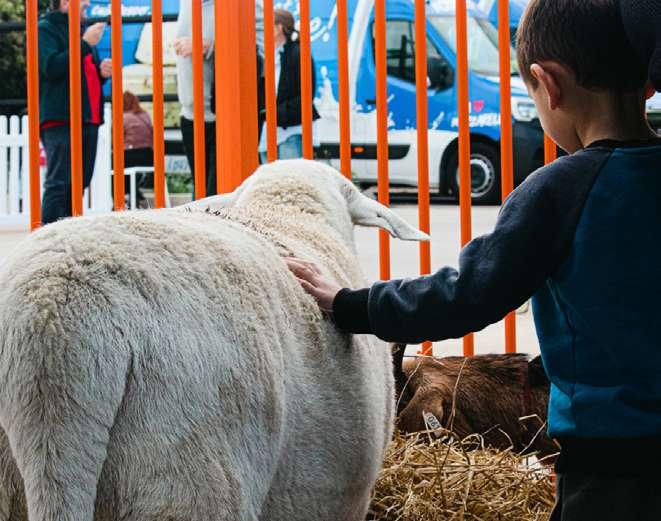




52 That’s Amore Cheese 66 Latitude Blvd, Thomastown VIC 3074, Australia Phone: (03) 9463 4200 ADVERTORIAL Thatsamorecheese Thatsamorecheese

CHASING NATURE’S ELIXIR LEARNING TO APPRECIATE OLIVE OIL IN THE TUSCAN HILLS
by Catherine Cervasio | Images provided by Catherine Cervasio
Olives are one of the world’s most treasured fruits, and their unctuous product can only be described as an elixir from Mother Nature herself. Follow us on a journey to learn more about this fruit.
of Chianti, I reach the town of San Polo. Here it’s easy enough to find the home of award-winning olive oil producer Pruneti, located on the Via Dell’Oliveto, which translates to the “road of the olive grove.” Tucked away in a corner of San Polo, the olive groves, which have been tended by the Pruneti family for more than four generations, sprawl across the land behind the mill, as far as the eye can see.
There are more than 30,000 olive trees and a further 10,000 trees currently being planted. These new trees will take around six years before they bear fruit worth harvesting. The olives here are typically harvested between mid-October and midDecember. The local climate and the dry, stony soil that provides ideal drainage for olive trees contribute to the unique character of the olives grown here and, ultimately, to an oil that boasts a complex bouquet of aromas and a distinct and intense flavor.
In a quest to better understand this marvelous fruit, I traveled through France and Italy to learn more about olives and what makes the olive oil produced there so different from Australian varieties.

Driving along the narrow olive tree-lined roads that wind their way up into the hills
I met with Pruneti’s head of marketing, who has been with the organization for five years. Katy’s passion and knowledge about Pruneti oil were evident. She took me through a tasting of single-variety oils (monocultivars). My favorite was a robust, extra virgin olive oil produced entirely from green Frantoio olives. As a long-time aromatherapist and passionate cook, I’m no stranger to smelling, tasting, and describing aromas. This olive oil was reminiscent of artichoke and tomato vine, has a peppery, long-lasting taste, and would complement red meat or tuna. It won a gold medal at the New York International Olive Oil Competition (NYOOC) 2021.
54 Segmento Issue XXX • Mar - May 2023
CUISINE & FOOD
According to brothers Gionni and Paolo, who took over the business in the 1990s, the success of Pruneti is the result of hard work, passion and knowledge passed down through the generations, as well as the drainage provided by the rocky landscape. Mother nature, of course, plays her role.
I was shown through the Pruneti production facility, where the equipment includes a state-of-the-art Pieralisi centrifuge (used to separate the oil from solids). It is one of only three such machines in the world. The speed, temperature, and separation time can be tailored to each batch of olives to maximize both flavor and antioxidant properties.
Co-founder of the Magnifico Olive Oil Awards in 2013 and Italian television chef

and passionate olive oil aficionado Matia Barciulli says that consumers need to be educated to make better choices when purchasing olive oil.
Olive oil needs to be protected from heat, light, and oxygen, and it needs to be purchased in an appropriately sized bottle. If you only use a little, buy a smaller bottle of oil. The harvest date is critical: an expiry date or “best before date” simply is not enough. Obtaining the most from high-quality olive oils is about proper storage in a cool dark place (or in a wine fridge) and ensuring the fruit is processed as close to harvest as possible, at a low temperature, then stored free of oxygen to maximize nutritional benefits and ensure a flavorful end product.
Matia is also the technical director of food and events for the Florentine Antinori

55 Segmento Issue XXX • Mar - May 2023
CUISINE & FOOD
The Pruneti brothers
Catherine Cervasio and Matia Barciulli
Group, a family-owned business that has been producing wine for 26 generations. It is hard to believe, but this equates to six centuries of continuous production. Matia heads up the cooking school, with classes held at the Antinori country estate, Fonte de Medici. Situated in the heart of the Chianti wine region south of Florence, this delightful estate dates back to the 1400s. There is a free wellness center, an outdoor pool, and a traditional restaurant on site.
I met Matia through a good friend who has lived nearby for over 20 years. He kindly invited me to join a private cooking class when I was in town. The cooking school experience allows food lovers to prepare, cook and taste regional Tuscan cuisine. That day’s menu was pollo alla cacciatora , handmade spinach and ricotta ravioli with butter and sage, and the traditional almond cantuccini biscuits. Olive oil features across the menus offered here (as does local wine), allowing Matia to educate guests on the importance of choosing high-quality olive oil.
In a world devoted to well-being, this golden oil, offering a myriad of health
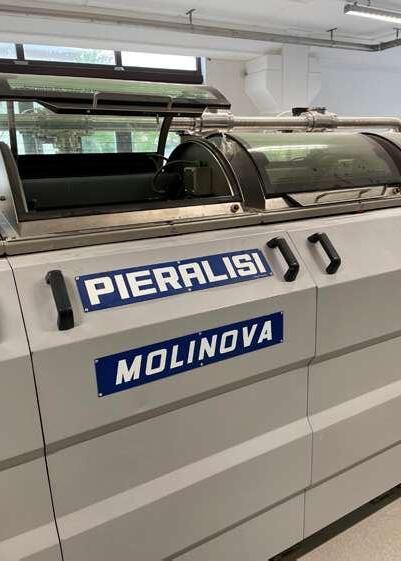
benefits, is a star. Consumers are now researching before they purchase and demanding transparency, armed with a greater understanding of the importance of origin, harvest, and storage. The tree of the most revered olive variety of Tuscany, the Frantoio, was even included in Oprah’s “Favorite Things” list of 2022. With a background in personal care product development, back home in Australia, I have sourced an awardwinning Mornington Peninsula extra virgin olive oil, high in polyphenols, for use in an organic skincare collection. Rich in healthy, monounsaturated fats, on the hot list of a global influencer, and with myriad culinary uses, olive oil is firmly in the spotlight. A recent Harvard study published in the Journal of the American College of Cardiology suggests that olive oil consumption, particularly when replacing butter, margarine, or mayonnaise, may be linked to a longer life span. What’s not to love?

56 Segmento Issue XXX • Mar - May 2023 CUISINE & FOOD
The Pieralisi centrifuge

THE RECIPES OF OUR CHEFS
PANINO CU PRUPPU RUSTUTU
Panino with roasted octopus
Panino cu pruppu rustutu, a roast octopus panino, was chef Onofrio Triolo of restaurant Da Onofrio a Furci Siculo’s contribution to the Messina Street Food Festival. In both 2019 and 2022, he took second prize in the rankings of the most popular street food on offer at the fest, selling 5000 panini.


Onofrio is best known for his fish, but he also holds his own in Sicilian savories. He appeared on Italian TV in a show called Il migliore chef Italia where he prepared an arancino with red Mazara prawns, stracciatella cheese, and wild fennel.
INGREDIENTS
FOR ONE 120 gr SANDWICH
200 gr Octopus
100 gr Potatoes
Lettuce Oil
Salt
Parsley
Black pepper
Garlic
Oregano Lemon
METHOD
Boil the potatoes for half an hour without removing the skin. Once cooked, remove from the heat, peel, and mash, adding salt oil, parsley, and black pepper.
Prepare a pinzimonio (dipping sauce) with parsley, oil, garlic, and oregano. Emulsify with an immersion blender.
Cut the lettuce Julienne style and season it with salt oil and lemon
Roast the octopus over charcoal (blanching the octopus is
unnecessary). Once cooked to the desired level, remove from the heat and cut into small pieces.
Cut the bread roll in half and toast it. Drizzle plenty of pinzimonio on the bread roll and spread some mashed potatoes over one half. Add the roasted octopus, more pinzimonio, and some dressed lettuce. Cover with the other half of the bread roll.
58 Segmento Issue XXX • Mar - May 2023
Recipes by Onofrio Triolo, owner and Chef of Da Onofrio restaurant in Furci Siculo, Sicily
A
TAVOLA
ARANCINI SICILIANI

Fried Rice Balls
INGREDIENTS
FOR 6 PEOPLE
FOR THE RAGÙ
1 Onion
1 Carrot
1 Celery stalk
2 Bay leaves
250 gr Minced ork
250 gr Minced beef
50 ml White wine
2 tbsp Tomato paste
350 ml Tomato puree
200 gr Peas
Extra virgin olive oil, salt, and pepper to taste
FOR THE RICE
1 kg Carnaroli rice
2 l Water
100 gr Butter
20 gr Salt
1 Bouillon cube, preferably homemade
Saffron
FOR THE FILLING
150 gr Mortadella
150 gr Provolone cheese
FOR THE BREADCRUMBS
200 gr 00 Flour
300 ml Water
400 g Breadcrumbs
Sunflower oil to taste
METHOD
Make the ragù by chopping the onion, celery, and carrot and sautéing them in a pot with olive oil. Add the minced meat. Brown well, and deglaze with the wine. Add the tomato puree, bay leaf, peas, and tomato paste, season with salt and pepper, and cook on low heat for about 3 hours. Allow to cool and place in the freezer for a couple of hours.
To make the rice, fill a pot with water and add the stock cube, salt, butter, and saffron. Toast the rice in another pot. When the water boils, pour in the rice. Stir and wait for it to come to a boil again. At this point, stir again, lower the heat, and let the cooking water slowly evaporate fully. The rice is cooked when the liquid has completely evaporated. When the rice is cooked, pour it onto a large baking sheet. Let it cool at room temperature.
For the breading, mix the flour with the water to form a thick batter. Pour the breadcrumbs into a wide container.
To make the arancini, wet your hands with water and take some rice, placing it on the palm of your hand. Make a hollow in the center and place the filling, consisting of a spoonful of meat sauce, mortadella, and diced provolone, into it. Close it up by adding more rice over the top and seal it tightly with your hands. When the arancini are ready, coat them one at a time in the batter and then the breadcrumbs. Now fry them in a pan filled with seed oil. Ensure the oil is at a moderate temperature, or the arancini will brown too quickly without giving them enough time to warm up and melt the cheese inside.
59 Segmento Issue XXX • Mar - May 2023
A Tavola
BUON APPETITO!
INVESTMENT PATHWAYS IN SINGAPORE FOR ITALIAN FIRMS
THE VISION OF THE AMBASSADOR OF ITALY MARIO VATTANI
by Agata Grimaldi
A year after his appointment, Mario Vattani shares his commitment to support the Italian businesses in the Asian city-state, presenting its achievements so far and its plans for the future.

Could you give us your impressions of your new role and describe some of the challenges?
Since my arrival here in the autumn of 2021, the goal that inspires our initiatives is to offer an up-to-date vision of Italy and of our excellence in the most avant-garde fields of industry, technology, scientific research, design and the arts. I think a better knowledge of Italy's industrial and innovative potential will strengthen the Italian presence in Singapore, and to relations between our nations. Most recently, it was a great privilege for our Embassy to welcome in Singapore the very first staging of the exhibition “The
Great Italian Vision”, a broad collection of the most significant works of the Farnesina Collection from our Ministry of Foreign Affairs. Also, last September, we relocated the Embassy headquarters to a more spacious and accessible space, right in the financial district of Singapore. This is more than a simple relocation; it represents a clear sign that Italy is conscious of Singapore’s growing relevance in this region. Southeast Asia will play an increasingly strategic role over the next 20 years, and Singapore is of special importance in this evolving framework. However, our companies have long used Singapore as a strategic base for access to the region. The opening of the new Embassy headquarters is part of a shift to a greater and more visible presence here, coinciding with the arrival of a scientific attaché and a cultural attaché, and the opening of the defense office and a Bank of Italy office.
In the post-pandemic phase, we have seen an increase in geopolitical tensions and uncertainties.
Singapore has strengthened its position as a safe harbor in these turbulent seas. What are the factors behind the success of the city-state?
There are various factors. Changes in Hong Kong in recent years have, of course, contributed. We are also witnessing a constant flow of professionals and companies from China, especially
60 Segmento Issue XXX • Mar - May 2023 BUSINESS & INNOVATION
Mario Vattani
from Shanghai. When I arrived, this process had already begun, and it could expand. From an Italian point of view, we can now prove to Singaporeans that there has been a change of pace in our bilateral relations. Since I have taken office, we have developed a series of initiatives in the City-State. The first Italian Festival was organized in 2022 according to a formula I had already worked on successfully in Japan, where I was head of the Economic Department of the Tokyo Embassy. The basic idea is to launch a series of activities under the same brand, without limiting ourselves to best known Italian brands like food, fashion, and tourism. We insisted on promoting events in our industry, science, technology and research. I feel we must do more to raise awareness about Italy’s excellence in the scientific, technological, and innovation sectors. Singapore is not a manufacturing hub and, unlike other countries, its wider public is not intimately acquainted with our productive system. For example, Japan has been importing high technology made in Italy for decades, while in Singapore it is our products which are better known. We are lucky to have important Italian companies represented here in Singapore, such as Fincantieri, Leonardo, and hi-tech brands like MER MEC. One of our most prominent construction materials companies, Mapei, is active in the construction of the new Tuas Mega-port. Italian technology is present in many iconic Singapore locations, from Gardens by the Bay to the subway system. We took advantage of the recent Formula One Grand Prix, which truly represented Singapore’s return to the international
stage after the pandemic, showcasing all the top Italian companies that are linked to the world of Formula One. Not only the racing car manufacturers, like Ferrari, but companies that provide infrastructure, like DZ Engineering, or tires like Pirelli. What approach should start-ups, entrepreneurs, or business people adopt when thinking of doing business in Southeast Asia?
Our method is to observe the priorities which Singapore identifies for its future vision, such as the Green Plan or the 30by-30 challenge to increase local food production, and adapt to their strategy by offering partnerships and collaborations with operators in the Italian economy. Singapore’s administrators are rightly proud of their accomplishments in the last decades, and we must show them that we are the right partner. Italy was selected as the only partner country to host the National Design Centre during Design Week last September, with a very interesting exhibition on new sustainable materials and with Italian startups who recycle in an innovative way. Now, thanks to the relocation, we have the tools to ensure a more proactive approach. We

61 Segmento Issue XXX • Mar - May 2023 BUSINESS & INNOVATION
have a new showroom, Sala Italia, at our headquarters at the center of the city’s Financial District where we can put on exhibitions. It is already in operation, and the renowned historian Giordano Bruno Guerri has just come here for a conference on D’Annunzio. Pirelli has also held a show here. I have recently signed two provisions that make both the residence and the Sala Italia available to companies for their promotional needs.
What is the situation in terms of scientific and technological cooperation?
An important bilateral agreement was signed in 2016, but the executive protocol was still missing. We have immediately set about activating it, and soon it will be finally up and running. There will also be several projects linked to startups where we have some ground to cover. The advantage of Singapore is that there is a vast pool of talent here. It is like a giant research laboratory; it has enormous potential.
Is Singapore an attractive place?

It absolutely is. Singapore’s administration is top-level, and Singaporean policy makers are respected all over the world. Singapore is playing a challenging role, thanks to its stability and strategic position. I would add that for Italy, as a European country it is also interesting to observe how Singapore manages a multicultural society effectively. In the same way, we value the opportunity to share experiences in the fight against terrorism and radicalization. These are issues on which I believe bilateral dialogue can be deepened.
In your opinion, what do Singaporeans think about Italy?
There is a great deal of curiosity on the
part of the Singapore authorities toward our new government. One of the reasons is the role of Italy in the Mediterranean. We are seen as a country that has managed to build a very close network with all the countries of the Mediterranean. There is also interest in how we responded to the problem of energy supply and the way our companies operate. Furthermore, in terms of corporate partnership, Italian companies are seen as capable partners that can closely analyze the needs of Singapore and adapt their offerings to the reality of the city-state. The affinity between Singapore and Italy also concerns the way in which Italy is perceived–not too dissimilarly from how Singapore sees itself. I think countries in this region of the world look to Europe and to partners like Italy. We, too, are considered something of a frontier country, extending deep into the Mediterranean, towards Africa, with all its opportunities and problems, just on the other side. Our dialogue goes beyond simply economic issues. Singapore has been consistently ranked as the easiest country in this region to do business, making it an ideal location for Italian companies looking to establish their presence in Asia. Singapore’s highly developed infrastructure and a strong, stable government provide a favorable business environment. Technology and investments play a leading role: with two sovereign funds, GIC and Temasek, Singapore is present, through the latter, in the port of Genoa and in the Moncler brand. It’s not surprising that in recent years we have seen a significant increase in the number of Italian companies operating in Singapore. This growth is a concrete demonstration of the opportunities and benefits that Singapore offers to our companies today.
62 Segmento Issue XXX • Mar - May 2023
BUSINESS & INNOVATION
EN ROUTE TO SUCCESS WITH ELEONORA SACCO AND HER ENTREPRENEURIAL TRAVEL PROJECT PAIN DE ROUTE
 by Ambra Dalmasso | Images provided by Eleonora Sacco
by Ambra Dalmasso | Images provided by Eleonora Sacco
Eleonora Sacco, traveler and entrepreneur, has transformed her passion for travel into a successful business. We explore her project and reveal that her secret lies within everyone’s reach.
“Since 2015, Pain de Route has been promoting conscious, respectful, and independent travel in little-known areas,” is how Eleonora describes Pain de Route: her travel blog and related social media pages where she shares travel stories and thoughts with tens of thousands of followers. It is also a consultancy service for organizing tailor-made trips and cultural tours. In addition, Eleonora is the author
of the book Piccolo alfabeto per viaggiatori selvatici (Little alphabet for wild travelers), co-author of the podcast Cemento and the new podcast Kult launched in January.
Eleonora says she was lucky to be born in a wealthy country, to a family with no major problems, in a city with three nearby airports serviced by low-cost flights –a series of factors that made developing a passion for travel possible.
63 Segmento Issue XXX • Mar - May 2023
BUSINESS & INNOVATION
Pain de Route is her way of giving back and sharing this passion with the world. During her many travels, especially in the Mediterranean and Eastern Europe, she explored different ways of traveling and living. She realized that “checklist” tourism did not enrich her personally. What made her feel alive were spontaneous encounters with local people who guided her to a deeper understanding of other cultures. She advocates internet-free travel, forcing you to rely on local people and their hospitality. Eleonora’s approach to travel crystallized into her blog. It was a space that simply aimed to tell stories and share thoughts and reflections gleaned from her travels. The blog gained an avid readership and has become an important point of reference in the panorama of online travel content focused on Eastern Europe. In her opinion, these countries influence the past, present, and future of
Europe and the wider world in ways we often overlook.
People immediately took notice of her novel approach to exploring the world, and requests to travel with her began pouring in from travelers wanting to experience her enthralling “wild,” spontaneous, and spartan way of traveling through areas recently devastated by conflicts.

Her project was born from a desire to share her passion and insights with local people but also with Italians back home. In an age in which many people, unfortunately, travel with the express purpose of sharing photos online, their experience can be stripped of immediacy and the joy of discovery by the constant need to document, curate, and seek validation from others. This mindless approach to travel has begun to weigh heavily on the landscape and cultural fabric of popular tourist destinations. Many places have become overcrowded, stripped of their charm, their economies entirely oriented towards satisfying the needs of tourists who queue to take selfies against the same backdrop as millions of others for the sake of likes on social media.
Eleonora has been able to harness the power of the internet to engage her followers by centering intimate portraits of the places and people she visits. Her content is engaging and promotes socially responsible, respectful, and contemplative tourism. Her responsible interpretation of “sharing” is the key to her success.
Eleonora explains that one of the aspects of her business she is most proud of is her attention to what she decides to share on social networks. In her opinion, the
64 Segmento Issue XXX • Mar - May 2023
BUSINESS & INNOVATION
Eleonora Sacco in Central Asia
journey must be experienced fully and in the present. Only later, if necessary, should it be documented. Everything she shares online, she explains, is the result of a careful assessment of any potential impact on the dynamics of the place and its people. She knows the danger of driving tourism in pristine areas and causing them to degenerate into banal Instagram spots. She feels strongly that sharing online should be secondary and not the engine that drives us to seek travel experiences. In an increasingly saturated travel sector, this is certainly a selling point that distinguishes Eleonora’s entrepreneurial project and which, along with her transparency and honesty, has given her success.
Alongside these core values is the importance she places on investing in quality content, preferring to provide lasting value. Quality content can bear fruit by acting as a springboard for other

projects. An example is the podcasts that Eleonora and her colleague Angelo Zinna offer free of charge while promoting her book and her group trips.
Pain de Route , Cemento , Kult , and P iccolo alfabeto per viaggiatori selvatici are all projects that, beyond offering interesting insights into Eastern European countries, offer a window on a way of traveling, thinking, getting to know places and people, exploring different realities, and, most importantly, looking past our screens that can become barriers to living in the moment as we travel the world.

65 Segmento Issue XXX • Mar - May 2023
BUSINESS & INNOVATION
Socotra, Yemen
IS AI PROMOTING THE RENAISSANCE OF THE ARTS?
by Nataša Ciabatti
Every year, the Victorian Multicultural Commission, in partnership with the Swinburne University of Technology, organizes a Multicultural Film Festival showcasing short films that portray everyday multiculturalism through powerful, uplifting, and thought-provoking films. At last year’s edition, the music video AKOSIA - GO was presented. Here, Ghanaian-Australian AKOSIA is a woman cyborg. Initially trapped in the embrace of a golden skeleton in the womb of a foreign planet, she finds the inner strength to free herself. The short video was recently shortlisted at various worldwide film festivals–the Kalakari Film Festival in India and the Global Network Lift-Off Film Festival.
Segmento met its director, Dale Crawford. A talented young film director and screenwriter, he is also an actor and a martial artist/choreographer. While this music video uses artificial intelligence to create the landscape around the singer, Dale has worked on other videos for the singer, where her facial expressions are artificially generated. This creative process was unimaginable a few years ago, but technology has rapidly evolved. The pandemic accelerated these changes because the media needed to evolve to get around restrictions that prevented people from meeting on set.
“The fact that a set can be created on a computer frees the directors from having to find the right place, from having to wait for the optimal light to shoot, or to wait for rain if the scene requires it,” explains Dale. “But it goes beyond that; it means the budget can be lowered when


66 Segmento Issue XXX • Mar - May 2023
AKOSIA's EP Black Diamond. Photo Michelle Grace Hunder. Artwork Dale Crawford
Artificial Intelligence is having a significant impact on the cinema industry. Segmento meets film director Dale Crawford to discuss the role of AI in filmmaking.
BUSINESS & INNOVATION
Dale Crawford
many extras are needed, to the extreme that actors could no longer be required as machines learn to simulate human emotions.” These developments provide endless opportunities for creating and, of course, for sharing content. We cannot predict where the film industry is going: We walk with the past in front of us. It slowly fades in front of our eyes as we head backwards towards the future unfolding behind us. We cannot predict what will happen, but we can learn from what happened before us as we witnessed it. New media displaces other media, allowing for their re-invention. For example, the invention of photography freed painting from realistically capturing our surroundings, and abstract painting was born. Today AI is allowing artists to make art in previously unimaginable ways. Simultaneously we are overwhelmed by images but don’t necessarily engage with them in meaningful ways.

We now consume art in different ways; our ability to process large amounts of images has increased, but this has not corresponded to an improvement in our visual literacy. On the other hand, our predecessors staring at the Sistine Chapel were much better than us at understanding the message portrayed by Michelangelo.
We are at a crossroads, and a dystopian vision is a common response to imagining the future. Yet, Dale’s most optimistic prediction is the birth of creative hubs, like the Vatican used to be during the Renaissance when artistic production boomed thanks to the investment of the wealthiest patrons.

 AKOSIA’s single Go. Photo Dale Crawford. Artwork Dale Crawford
AKOSIA’s single Go. Photo Dale Crawford. Artwork Dale Crawford
67 Segmento Issue XXX • Mar - May 2023 BUSINESS & INNOVATION
AKOSIA’s music video for the song Better. Image Colin Anderson. Artwork Dale Crawford
LOVE. LAUGH. PROTECT.




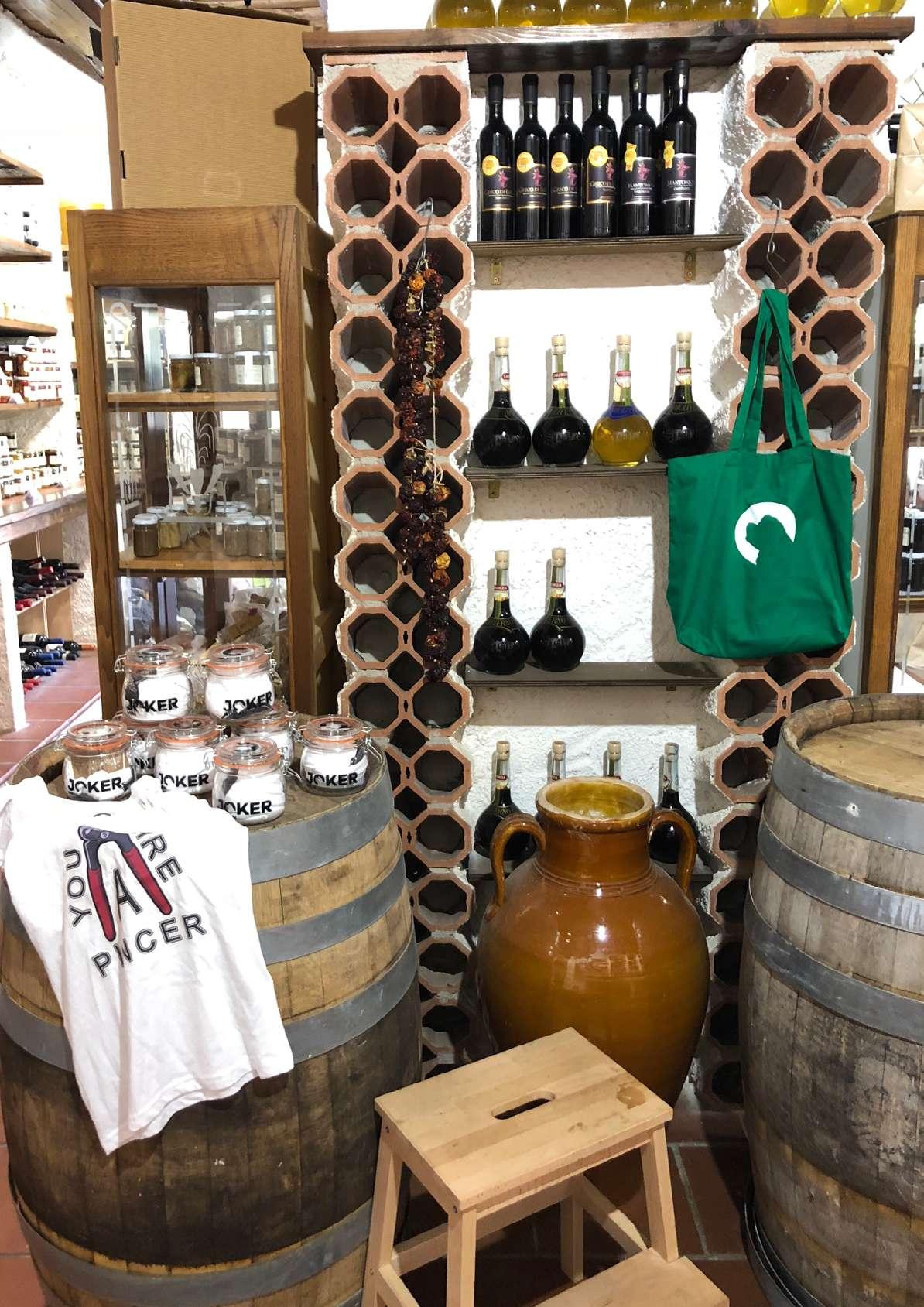
animals with kids the earth


LA STRADA
LOOKING BACK, MOVING FORWARD
by Vincenzina Nicolazzo & Martin Plowman | Photography by Alfonso Merafina
Towards the end of the Appian Way, Castel del Monte appears. Our logo is inspired by its octagonal plan. We like the idea of spreading, through the pages of Segmento, a message that somehow harkens back to the great Swabian ruler who commissioned it.

70 UNDER THE COVER Segmento Issue XXX • Mar - May 2023
Throughout the Italian peninsula, one is struck by the historical, artistic, and cultural evidence of eras far removed from us that have survived intact through the ages. “All roads lead to Rome,” is the famous saying, but perhaps the most important road was the Appian Way, which connected the Eternal City to Southern Italy. This ancient route was one of the Romans’ earliest and most important roads and features some of Italy’s most iconic sights. Stretching over 580 km across Italy from Rome to the Roman colony of Brundisium, now Brindisi, one reaches the Castel del Monte, an Apulian town in the municipality of Andria. Here, an architectural masterpiece of Swabian architecture and one of the most remarkable buildings of the Middle Ages stands tall, atop a hill. Construction of the castle began around 1240 under orders from Emperor Frederick II. Apparently built for defense, it was never finished, leading to an eternal debate about its true purpose. Intriguingly, its unique design hints at a sort of The Da Vinci Codestyle symbolism. Based on repetitions of the number eight, the floor plan is a large octagon with an octagonal tower at each corner. Inside each tower are two floors, each with eight rooms. Over the centuries, a great deal of arcane significance has been ascribed to the Castel del Monte, with theories ranging from it representing an image of the universe to being built by the Knights Templar. The author Umberto Eco, who loved toying with conspiracy theories, based the mysterious
library in his 1980 novel The Name of the Rose on the Castel del Monte.
The castle has Gothic and classical architectural elements, testifying to the cultural versatility of the ruler who commissioned it. Frederick II was crowned Holy Roman Emperor, King of Sicily, King of Germany, King of Italy, and King of Jerusalem at the behest of Pope Onorio III. Yet, he always preferred the title of King of Sicily, the island at the center of the Mediterranean and at the

Undercover the 71 Segmento Issue XXX • Mar - May 2023


72 Segmento Issue XXX • Mar - May 2023 UNDER THE COVER
crossroads of Greek, Arabic, and Jewish traditions where he set up his capital.

Frederick II was also a scientist, scholar, architect, poet, and composer. He populated his court with writers and poets, giving rise to the Sicilian school of poetry. In politics, he believed the empire should guarantee a kind of unity but that the sovereigns of Europe should be free and autonomous with the emperor as guarantor of the balance between the states. This remarkably modern
idea denotes an extraordinary spirit of tolerance and openness to different cultures that only an enlightened mind like that of Frederick II could have conceived.
Segmento based its logo on Frederick II’s castle because, like the Emperor who invited writers to his court, we cherish bringing people together, promoting dialogue and collaboration, and celebrating diversity by providing a space for writers from all backgrounds to tell their stories.

73 Segmento Issue XXX • Mar - May 2023
UNDER THE COVER
BORN TO BE AUTHENTIC
PROVOLONE VALPADANA PDO IS NATURALLY LACTOSE-FREE*
With the growth of milk-substitute products marketed to people with lactose intolerance in Australia, great news comes from the www.borntobeauthentic.eu project for those who do not want to give up the flavors and benefits of real dairy cheese.

Provolone Valpadana PDO is naturally lactose-free, making it a great solution for those who do not want to give up dairy products and their benefits. Researchers have shown that a substantial portion of the Australian population avoids dairy products, and most do so because of gastrointestinal symptoms. Lactose intolerance is the most commonly self-diagnosed food intolerance in Australia, although, according to recent data, it has actually been found in only six
percent of Australians. Perhaps this is part of the reason why the consumption of milk substitutes is growing. According to data published by the Australian Bureau of Statistics (ABS) in 2022, the amount of dairy products purchased in Australian supermarkets and other food retailers increased by four grams per day between 2018-19 and 2020-21, compared with a decline of four grams per day over the same period.
ADVERTORIAL
BORN TO BE AUTHENTIC
74
However, there is good news for those who limit their dairy intake due to digestive problems from the “Born to Be Authentic–Provolone Valpadana, a PDO cheese from Europe” information project: www.borntobeauthentic.eu.

Provolone Valpadana PDO, having a maturation phase of 30 days for the mild type and at least 90 days for the piquant type over 15 kg, offers the necessary guarantees for the natural breakdown of the lactose




present in the cheese. In addition, recent chemical analyses show that glucose and lactose are almost completely degraded, if not completely absent, as early as ten days into ripening, meaning that even the mild type and formats up to six kg, where ripening is shorter (ten days), to be consumed in complete safety.

75
* lactose content is less than 0.001 gram per 100g.
ADVERTORIAL
More information by the Protection Consortium, can be found on the official website of the project, which can also be followed on: Borntobeauthentic.eu Borntobeauthenticeu


www.borntobeauthentic.eu THE EUROPEAN UNION SUPPORTS CAMPAIGNS THAT PROMOTE HIGH QUALITY AGRICULTURAL PRODUCTS CAMPAIGN FINANCED WITH AID FROM THE EUROPEAN UNION The
the views of the
and is his/her sole responsibility. The European Commission and the
responsibility for any use
be
of the information it c ontains
content of this promotion campaign represents
author only
European Research Executive Agency (REA) do not accept any
that may
made
IN EACH ISSUE, WE INTRODUCE ONE OF OUR TEAM MEMBERS

FEATURING JESPER STORGAARD JENSEN
Nice to meet you, I am Jesper from Rome! Not a very Roman name? You guessed it! I am from Denmark but I have made the eternal city my home since 1997. Here I worked for ten years at the Danish embassy in Rome, dealing with Italian economics and politics. In 2008 I left the embassy to pursue my passions: journalism and photography. I love writing about Italian society –wine, food, travel articles,
culture, politics, and interviewing people–and I have been published in 19 different countries worldwide. So far, I have published three travel guides about Rome and Italy, and a fourth guide –about Rome’s restaurants–was published in Denmark in December 2019. In April 2022, I published a very different book about Rome, “The invisible Rome,” a neorealist portrait of this incredible place.

Unapologetics
Meet our Team
77 the Segmento Issue XXX • Mar - May 2023
The Lying Life of Adults
Scoperta
Directed by the Neapolitan director Edoardo De Angelis and starring Valeria Golino, the series is based on Elena Ferrante’s book and depicts Giovanna’s transition from childhood to adolescence during the 1990s in a Naples that is riven into two halves that fear and loathe one another.
We recommend it because …
Whether you read it or watch it, we have no doubt The Lying Life of Adults will satisfy lovers of Elena Ferrante and her stories set in Naples. In this story, you will experience the 1990s in the city through the eyes and imagination of a local girl.
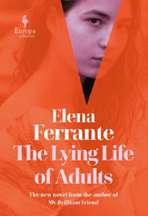
A social project of Gruppo Volontarius, Radio Comini is an intercultural and intergenerational web radio program made at the reception center in Via Comini in Bolzano by its young guests along with University students.



We recommend it because …
The radio project believes in the power of dialogue and cultural exchanges to create bridges and bring people together, a mission aligned to ours at Segmento! Now in its second season, it is available on Spotify.
The exhibit about the great Italian filmmaker is now on at the Museo Nazionale del Cinema di Torino until 15/05/2023.
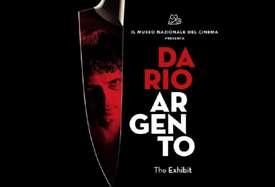
We recommend it because …
Tim Burton once said that Federico Fellini and Dario Argento share the ability to capture dreams. The exhibit about this visionary master of the thriller is a chronological journey through his entire body of work, from the beginnings of The Bird with the Crystal Plumage (1970) to his latest work Dark Glasses (2022).
78
Alla DISCOVER MORE ABOUT ITALY AND ALL THINGS ITALIAN
Radio Comini - La Radio di Strada
Segmento Issue XXX • Mar - May 2023
“Dario Argento, the Exhibit”








EMAIL segmento@segmento.com.au | PHONE +61 410 860 036 Subscribe For lovers of all things Italian XXV, Dec 2021-Feb 2022 Love, Art, Power and Divine Inspiration Issue XXVII, Jun-Aug 2022 in a Global World of Change Identity and Belonging Issue XXVIII, Sep-Nov 2022 THE MANY SHAPES OF BEAUTY La Bellezza XXIX, Dec 2022 Feb War ... or Peace?
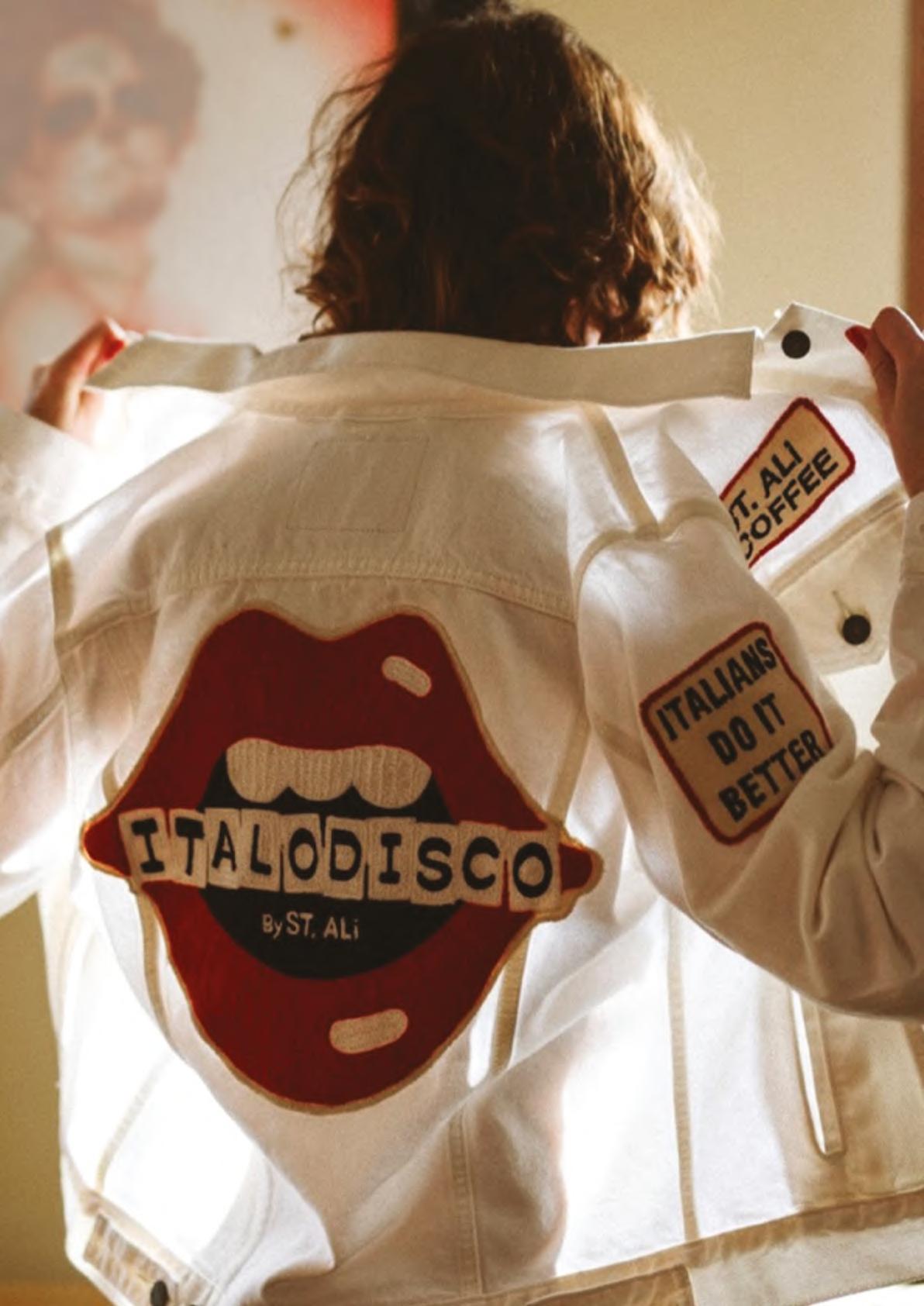










































































 Jesper Storgaard Jensen | Images provided by Jesper Storgaard Jensen
Home to 200 people, this abandoned factory on the outskirts of Rome is a treasure trove of beauty with more than 650 works of contemporary art.
Jesper Storgaard Jensen | Images provided by Jesper Storgaard Jensen
Home to 200 people, this abandoned factory on the outskirts of Rome is a treasure trove of beauty with more than 650 works of contemporary art.



























































 by Ambra Dalmasso | Images provided by Eleonora Sacco
by Ambra Dalmasso | Images provided by Eleonora Sacco







 AKOSIA’s single Go. Photo Dale Crawford. Artwork Dale Crawford
AKOSIA’s single Go. Photo Dale Crawford. Artwork Dale Crawford
































